












Sheryl Dixit
MELBOURNE COOORDINATOR
Preeti Jabbal CONTRIBUTORS
Prashant Dixit, Hasnain Zaheer, Astha Singh, Shafeen Mustaq, Mohan Dhall, Sydney Sririnvas, Noel G De Souza, Anitha Venkataraman, Petra O’Neill, Kalyani Wakhare, Nancy Jade Althea
ADVERTISING MANAGER
Vivek Trivedi
02 9262 1766
ADVERTISING ASSISTANT
Nitika Sondhi
02 9279 2004
DESIGN
Danielle Cairis
Proud member of:
Indian Link is a fortnightly newspaper published in English. No material, including advertisements designed by Indian Link, may be reproduced in part or in whole without the written consent of the editor. Opinions carried in Indian Link are those of the writers and not necessarily endorsed by Indian Link. All correspondence should be addressed to
Indian Link
Level 24/44 Market St, Sydney 2000 or GPO Box 108, Sydney 2001
Ph: 02 9279-2004 Fax: 02 9279-2005
Email: info@indianlink.com.au

www.indianlink.com.au
LUTHRAPAWAN
“It was the best of times, it was the worst of times,” Charles Dickens wrote famously, in the opening lines of his novel A Tale of Two Cities (1859). “It was the age of wisdom, it was the age of foolishness, it was the epoch of belief, it was the epoch of incredulity, it was the season of Light, it was the season of Darkness, it was the spring of hope, it was the winter of despair, we had everything before us, we had nothing before us, we were all going direct to Heaven, we were all going direct the other way”.
An appropriate description of what we’ve experienced in the last few weeks!
The ‘best’ before us was the wonderful spirit of selflessness amongst the local Australian community as they came together to back our firefighters. The Rural Fire Service (RFS) battled bushfires, at times there were over 56 raging simultaneously, in temperatures ranging from mid to high 30o, strong winds of over 30 km/ hour and low humidity. While over 200 homes were destroyed across the Blue
Mountains, people living in Sydney were not immune to the conditions, as the city was enveloped in a haze of smoke. Media was at the forefront of reporting on the emergency situation confronting NSW, and not only detailed progress of the fires, but also spoke of the work done by the firefighters.
The RFS is largely a voluntary organisation and its various members come from all walks of life. Stories emerged of Albert Newton (78), a volunteer veteran of over 60 years with the RFS, playing his part in warding off a fire at Bilpin.
A prominent face of the NSW fires has been Shane Fitzsimmons, Commissioner of the NSW RFS, who has been personally affected by fire tragedy. In 2000, his father George Fitzsimmons was back-burning in the Ku-ring-gai Chase National Park when the fire got out of hand, killing him and three colleagues. Shane was 31 and since then, he has dedicated his life to firefighting. These stories are a reminder of the passion felt across communities at times of crises, and new migrants can learn much about their new home from these accounts.
Also commendable is the maturity in which the State Government handled the crises. Barry O’Farrell and his team of ministers should be congratulated for backing RFS Commissioner Fitzsimmons and allowed him to take charge of the
situation. Politics took a backseat as experts dealt with the emergency at hand. Among the ‘worsts’ however, is the total lack of connection with local issues that Indian government officials have shown as they make the rounds of the community during our festive season. Although much mention was made of the tragedy at the recent Diwali Mela at Sydney Olympic Park by guest speakers as well as MCs, Indian government officials made no connection with this issue that is intrinsically involved with the lives of the Indian diaspora here. It is hoped that the connect with current local issues increases over time.
The ‘worst’ also came courtesy of Immigration Minister Scott Morrison who has increased his rhetoric against asylum seekers. While heavy-handed media restrictions on access and reporting on the issue is prevalent, calling them ‘illegals’ is harsh and confronting. This attitude defies the ‘fair-go’ ethos of Australia. There may be some rorting of the system, but others are genuine refugees. Upon assessment, call one group illegal if you have to, but treat the other with dignity and compassion. They will live in Australia and contribute, perhaps even join the RFS and give their best for their adopted community.
Pawan Luthra is the 2012 Parliament of NSW Multicultural Journalist of the Year.









For the Indian community, sexuality in any form is rarely discussed openly and when it comes to homosexuality, it becomes ten times harder. If you have grown up in a traditional family, chances are that you will most likely take those values with you through life, even if you migrate to a western country, like Australia. You might find yourself very uncomfortable in a lot of situations. This could be at work, university, shopping malls or train stations.
In Australia being homosexual is socially acceptable. Homosexual is the term which is used for a male who is gay, or a female who is lesbian. The broader or updated term is GLBT (Gay, Lesbian, Bisexual, Transgender). If you are homosexual, most of the time your family, friends and coworkers are very respectful of your choices. But this might not always be the case if you are from an Indian background. In saying that, it doesn’t mean all Indians are against the GLBT community, but we are talking about the majority.
I come from a traditional Indian family and I am proud of it. Being part of that culture has taught me a lot of things. I have so much respect for my culture and tradition. I probably didn’t have very a good opinion about the GLBT community until I got to know a lot of them through work and university. Sometimes we look at homosexuals as people who have
made the wrong choice, which is where we are making the mistake.
Homosexuals are absolutely normal people like us. They share the same feelings and belong to the same society as we do. They deserve the same respect as we would give to any other person of the community. Being homosexual doesn’t disqualify them from being normal citizens.
Australia is a multicultural country and the beauty of this great nation is that we are all equal. No one gets excluded based on their age, nationality, religion, gender or sexuality.
Regardless of your opinion about homosexuality, treat them equal, respect their choices, be genuine and stand up for them if you have to. We are all entitled to an opinion, but that doesn’t mean we should be disrespectful to them.
This year a poll conducted by pew research shows that 79% of Australians are in favour of same sex marriage. Homosexuals must be welcomed with dignity. Every sign of unjust discrimination should be condemned.
You don’t have to accept someone’s choices, but you do need to respect them. Don’t try to change their choices just because you don’t agree. Education should be to promote kindness and compassion.
Jot
The recent views in the local media in Fiji regarding proficiency in one’s mother tongue and learning a new language or languages have prompted me to share my language learning experiences.

Recalling my childhood school days, l attended a school that had an extremely rigid language policy; my mother tongue was despised in that institution. Speaking in my mother tongue meant losing my dignity and self-respect! A group of us were caught communicating with one another in our mother tongue in the school’s playground during a lunch break and the teacher on duty put us all on detention. We were made to run around the school’s playground for 30 minutes in the mid-day heat. We suffered very badly from extreme heat exhaustion and while doing our punishment we slowed down but the teacher kept on yelling, “You still have fifteen more minutes to go... run! Run! Run! Fast! Fast! Fast! Don’t slow down! Keep running... keep running till l say STOP!”
My other friends at the school were also trapped in a similar situation, and by ‘desecrating the institution’s sacred language code’ they were made to scrub the school’s corridors, clean the toilets, dig the gardens, and some even had to wear a label around their necks throughout school hours with very large and bold printed message, “I’LL ALWAYS SPEAK IN ENGLISH!”
The school’s snobbish approach and rejection of my mother tongue generated a lot of anxiety in my small village community in Fiji. My parents too were deeply alarmed and so we were sent to another school. I had five brothers and sisters and every morning we travelled daily by bus from our village to Lautoka Muslim Primary School, a multicultural school which had very effective language learning programmes during my time, where all languages were respected and treated equally.
My head teacher during that time was Mr Mohammed Ishaque, a very inspiring gentleman who was widely respected in the local community. I felt very proud going to that school; l was very happy and comfortable in my new school and l spent eight years there learning languages and other subjects, and was exposed to the community’s values and virtues of self-
discipline, devotion to oneself, respect, civic pride, honesty, hard work, love, compassion, humility and success! The environment was very friendly and motivating and l gained proficiency in Hindi, Urdu, English, and Fijian. At home my parents played a vital role in my education, proficiency in languages and character building. We were exposed to a huge variety of reading materials in Hindi literature and other literacy materials in English and Urdu. By the age of ten l accumulated proficiency in my mother tongue and had read all my community’s literature. The local media in Fiji, which is, Radio Fiji, Fiji Times and Shanti Dut, also had an influential role in my communicative skills. My parents encouraged us to write for the local media too.
There was no shortage of jobs for me when l completed my primary and secondary education. l was approached by the principal of a prominent school in Lautoka to design a remedial reading programme in the school to promote literacy and proficiency in students who were slow learners and had great difficulty in reading, writing and were lacking in other communicative skills.
For me, learning is an ongoing continuous process in life; we learn and acquire new skills everyday and after completing my tertiary education l later enrolled in the adult learning class at University of the South Pacific and studied French and Japanese language too!

I have very liberal views about learning and acquiring proficiency in a new language. The nature and complexity of the human brain are such that we can learn new things at any stage in life. Effective learning and acquiring knowledge and skills in life depend on our own inner potentials too, our determination, and our perception about life. My day-to-day exposure to different social situations and interaction with diverse cultural groups in Fiji have given me a new and brighter perception about my immediate environment; a deep understanding of diverse groups and how their lives operate, their values, virtues, principles, social norms and love for humanity.
shah
Melbourne, ViC


diWALi

VisiON 2020 diwali dinner
sat 2 Nov 6.45pm
Annual Diwali dinner, at The Don Moore Community Centre, Carlingford. Funds collected will be used to support a worthy project in Bangalore, India called MITU (Multiple Initiatives Towards Upliftment) to help provide an affordable and eco-friendly aid for personal hygiene to school girls in rural areas of India. ‘Special Diwali Sweets’ offer is on again.
Don’t forget to place your order for Diwali sweets and savouries sourced from Grand Sweets and Adayar
Ananda Bhavan, Chennai, India. (Tirunelveli Halwa sourced from Archana Sweets). Please email your orders as soon as possible to vision2020au@gmail.com.
Deadline with the vendor is 15 October 2013. Orders can be collected before the Diwali dinner event.
Details: Beema 0424 943 590, www.vision2020australia.org.au
Hornsby sat 2 Nov 5.30pm
Laxmi poojan, bop till you drop, fashion show, pyrotechnics, Bollywood dances, lucky draws and much more at Hornsby RSL War Memorial Club.
Details: Kamini Sahni 0401 059 923.
Chinmaya Mission sun 10 Nov 9.30am-11.30am
Diwali Trivia for the family at Crestwood Community Centre, Baulkham Hills. Free program, including pooja and trivia, lots of prizes to be won and silent auction. Details Chinmaya Sannidhi 02 8850 7400, www. chinmaya.com.au
sPiRiTUAL swami swaroopanand a free talk Wed-sat 13-16 Nov
At Sydney Bahai Centre, Silverwater.
Details: Br Gopalji 02 8850 7400 or www.chinmaya.com.au
gopakuteeam
4th sun of every month 4pm-5.30pm
The Global Organisation for Divinity runs free spiritual education classes for children aged 4-12 years. At Crestwood Community Centre, Crestwood Drive, Baulkham Hills. Parents welcome to join in.
Details: Jayashree 02 9620 4676.
AWgP Balsanskar shala
BalSanskar Shala teaches children Vedic slokas, Vedic maths, games, personality development, knowledge of great Indian personalities, and other aspects of Vedic culture.
Details: Gayatri Pariwar parijan Parag/ Niyati Wani 0421 403 852
MisC
Hindi Public Retreat
Fri 15 Nov (5pm to start at 7pm) – sun 17 Nov 2pm
Organised by Brahma Kumaris Australia with the theme ‘Positive Thoughts Healthy Relationship’. During the retreat we will discuss and explore how the quality of our thinking affects our attitudes and behaviours and therefore how this in turn affects those in our contacts. This retreat will be conducted in Hindi language. Held at Inner Space Retreat Centre, 150 Macarthur Drive, Wilton, NSW.
Details: BK Asha on 0435 196 146 or BK Devendra on 0433 963 807, illawarra@ au.bkwsu.org or www.brahmakumaris.org/au

At these difficult and sad times of bush fires in NSW and around Liverpool, our thoughts are with the families who have lost loved ones, their homes and livelihoods.
We also thank the hard working fire fighters and emergency workers in affected communities. I will be asking Council at our next meeting to donate $10,000 to the victims of the fires on behalf of the people of Liverpool.

In October, Council held the first Welcome to Liverpool Mayoral Reception for new businesses and existing businesses which have expanded in Liverpool. Congratulations to those businesses involved.
Max Potential - a leadership program for young adults which I am involved in is recruiting coaches for its 2014 program. Visit www.max-potential.com.au or phone 9004 7866 for more information.
I am hosting my Mayor and Councillor mobile office at various locations around Liverpool to listen to what the community has to say. The next mobile offices will be held on saturday 9 November at Lakeside shops from 9.30am-11.30am and Wattle grove shops 12.30pm-2.30pm. Come and say hi!
Are you having any of these problems: love, relationship, facing divorce, family problems success in business, career, spate of bad luck, personal worries, court cases, impotency, breaking curses, witchcraft and many more...
I F SO THEN CALL k ALELU TODAY FOR HELP NOW ON : 04 69 36 75 12
Very rapid results and 100% guarantee


Surprising
Pure




MMost of us have many happy memories of Diwali. Carefree, joyful times spent in the company of family and friends, made more exciting with new clothes, an abundance of festive food and fireworks. We have enjoyed the Lakshmi puja, Bhai Dooj and visiting homes gaily decorated with diyas, lights and rangoli
So what made those Diwalis gone past special? Here, Indian Link asks community members what made the festival truly memorable for them. In this yaadon ki baraat, some recount happy times, others tell of scary incidents, but all are wonderfully nostalgic and we hope, bring a touch of light and laughter to your own celebrations this year.
Mandeep rana
Uzma Beg

My very first Diwali was in the year 2003.

Coming from Pakistan, I had had no previous exposure to this festival.
But the very first day at work as a broadcaster on Indian Link Radio, also coincided with the Festival of Lights. My first ever radio show therefore, was on Diwali. No wonder it is my most memorable Diwali!

It is memorable for another reason, though. My co-host that morning, was my colleague Khalid Malik. Two Muslims, and both

Now how’s that for Australian multiculturalism?!
As we got down to work with our carefully prepared playlist of upbeat songs, the phone lines lit up. It was a barrage of listeners calling in to wish their friends and family Happy Diwali. There was much fun and laughter, and the positive energy was infectious. We got completely caught up in the joy of it all… I enjoyed myself thoroughly. We ended with, you guessed it, plenty of puppies and jhappies!
What a happy first show it was for me. I felt lucky to have got acquainted with the listeners in an atmosphere of joie de vivre, and that

with me since then, and to the hundreds more who have joined in through ten more Diwalis, I say, thank you, and Diwali Mubarak! Khalid Malik has since moved back to Pakistan and made a name for himself in the entertainment industry there. How I would love to have him back on my show on Diwali this year to mark the tenth anniversary of our first appearance together. Are you listening, Khalid miya? Diwali 2013 will be a special one for Uzma as she clocks up ten years behind the microphone at Indian Link Radio, a full decade of non-stop diva-style dimaagchaat-buk-buk. Congrats, Uzma!
One of our most memorable Diwalis is when my wife Simran and I took our ten-monthold daughter Ashna to India during Diwali. The poor babe got such a fright with the patakas on Diwali night that she caused quite a panic amongst the family members. She squealed non-stop as the firecrackers went off outside. Of course we thought she would get used to it shortly, but no! The louder they got, the harder she cried. Everyone ran helter-skelter to close the doors and windows and cover her ears and block air spaces with towels and sheets. But all the poor darling did was turn redder and redder with the constant crying. As for her mum, she turned redder and redder as she tried hard not to cry! And me, I just stood there wondering whether to cuddle my two girls in protection, or storm outside and give the pesky teenage revellers a piece of my mind, or drag a quilt out from somewhere to further soundproof the doors... or just eat another piece on burfi in resignation. It was one heck of a long Diwali night before the noise subsided and the fruit of my loins fell into exhausted sleep.
And if you have had a ten-monthold, you will know the kind of exhausted sleep Simran and I fell into as well!
Many friends tell us that one of their fervent Diwali wishes is to be able to take their kids to India to see an authentic Diwali. Diwalis in Australia are so sanitised, they complain; no patakas, bad mithai, no extended family... our kids must see the real thing. But then I remember Ashna’s first Diwali and wonder, will your kids really enjoy it?
This Diwali will be a special one for Mandeep Rana and partner Dimpy Singh, as their Terrey Hills Restaurant Urban Tadka wins two awards in as many months (state level and national level Savour Australia 2013 Award for best Indian restaurant ), in its second year of operation.











My most memorable Diwali experience was in 1975, at my home in Srinagar in the beautiful Kashmir valley. We lived in a neighbourhood that had Muslim, Sikh, Buddhist and Hindu homes right next to each other. Unlike today when Kashmir has become synonymous with violence and conflict, in the 1970s the valley was synonymous with religious and cultural harmony and togetherness.
On the morning of Diwali in 1975 (I was 13 years old then), all the children in the collected money from the elders and then went to buy the best fireworks from nearby Maharajah bazaar, which was converted into huge fireworks supermarket. And in the evening, instead of celebrating Diwali just in our own houses, everyone, Sikhs, Muslims, Buddhist and Hindu families, assembled in the grounds of nearby Amar Singh College, ate together and then watched the spectacular display of fireworks. didn’t matter which faith we

belonged to, or our political loyalties, we all came together in celebrating the victory of good over evil. Those were the days, unimaginable in Kashmir today!
It’s a special Diwali for Dr Mattoo as the AII has just concluded its fifth successful year of operations, and continues to build positive Indo-Oz relations.


just after Guru
Purb, which is equally significant, if not more so for us Sikhs. Then there’s that much awaited afternoon when we would be taken to the shops to purchase our choice patakas; the endless parties night after night in the week of Diwali as we made the rounds to homes of close friends the special little things I would have for all my cousins, especially as the oldest cousin in the clan; the special moments with each of my Bhai Dooj (Brothers’ Day). Oh, there definitely were some not-so-happy moments which we all still laugh at today, such as when my hair went up in flames from a stray phooljhadi (sparkler), or when my brother burnt his hand! But overall, the outstanding memories are those magic moments of sharing and happiness and non-stop partying… A very Happy Diwali to you. May the diyas enlighten you, may the crackers add a sparkle to you; may the candles fill you with hope, and may your fears go up in smoke!
Congrats to SBS

Punjabi broadcaster Manpreet as she celebrates her Walkley Award nomination and UNAA’s media award for increasing awareness of women’s rights and issues. It’s certainly going to be a happy Diwali for her.

Every Diwali is special for me with my family, friends and children from our Hindi School, but the most special in some ways was the one in 2011! That year’s Diwali was like a dream come true for me, as I celebrated it with a few hundred mainstream primary school kids. Students from seven mainstream schools had got together at Cronulla Public School to mark Diwali. And what a Diwali party we had!
There were Indian outfits galore for teachers as well as students; a traditional Indian welcome ceremony; Indian music and dance, and some sumptuous Indian food for all. The mostly non-Indian kids learned about Diwali as they enacted scenes from the (including a Ravana figure complete with ten heads), crafted colourful diyas as candle holders, and drew rangoli lessons. And the Bhangra and the Bollywood dancing, what a hit!



My only regret was that alas, we did not have sparklers… Having worked towards making something like this happen for 24 years, it was truly exhilarating to see it all come to fruition. I cannot express in words how I felt but hopefully my photos will say it all!

The event was initiated by the Principal Mr Peter Banks and the India Calling teacher and Assistant Principal Mrs Joanne Williamson. A huge thank you to Dr Phil Lambert PSM, art teacher Ms Jacqueline Hackfath, Ms Janet Freeman, Hindi teacher Ms Kulwinder Kaur, dance teacher Purvi Desai, Bhangra boys Mahtab & Chiranjiv Walia and music experts Mr Vinod Rajput and Mr Bulla Singh. India Calling is a multistage teaching resource currently complemented by a Hindi language program, trialled and developed in the Sydney Region of the NSW Department of Education and Communities’ Expanding Horizons with Asia initiative. It involves both face-to-face lessons presented by a specialist Hindi teacher, augmented by videoconference technology to connect a total of 520 students in Year 3 and 4 across all the participating schools in the state. This innovative educational program shares resources to develop an understanding of India and provides insight into the Hindi language. It also builds vital ‘people-to-people’ links among school children of both countries and sows the seeds for opening up of opportunities for considerable growth through education, including exchange of language and educational programmes and deepening ties between Indians and Australians. In 2013 we have established sister school partnerships in India with Bloom School, the Shiv Nadar and Vasant Valley Schools in Delhi and the Heritage School in Kolkata. This Diwali will be a special one for Mala, as the India Calling program which she has helped devise and coordinates, marks three years since inception.

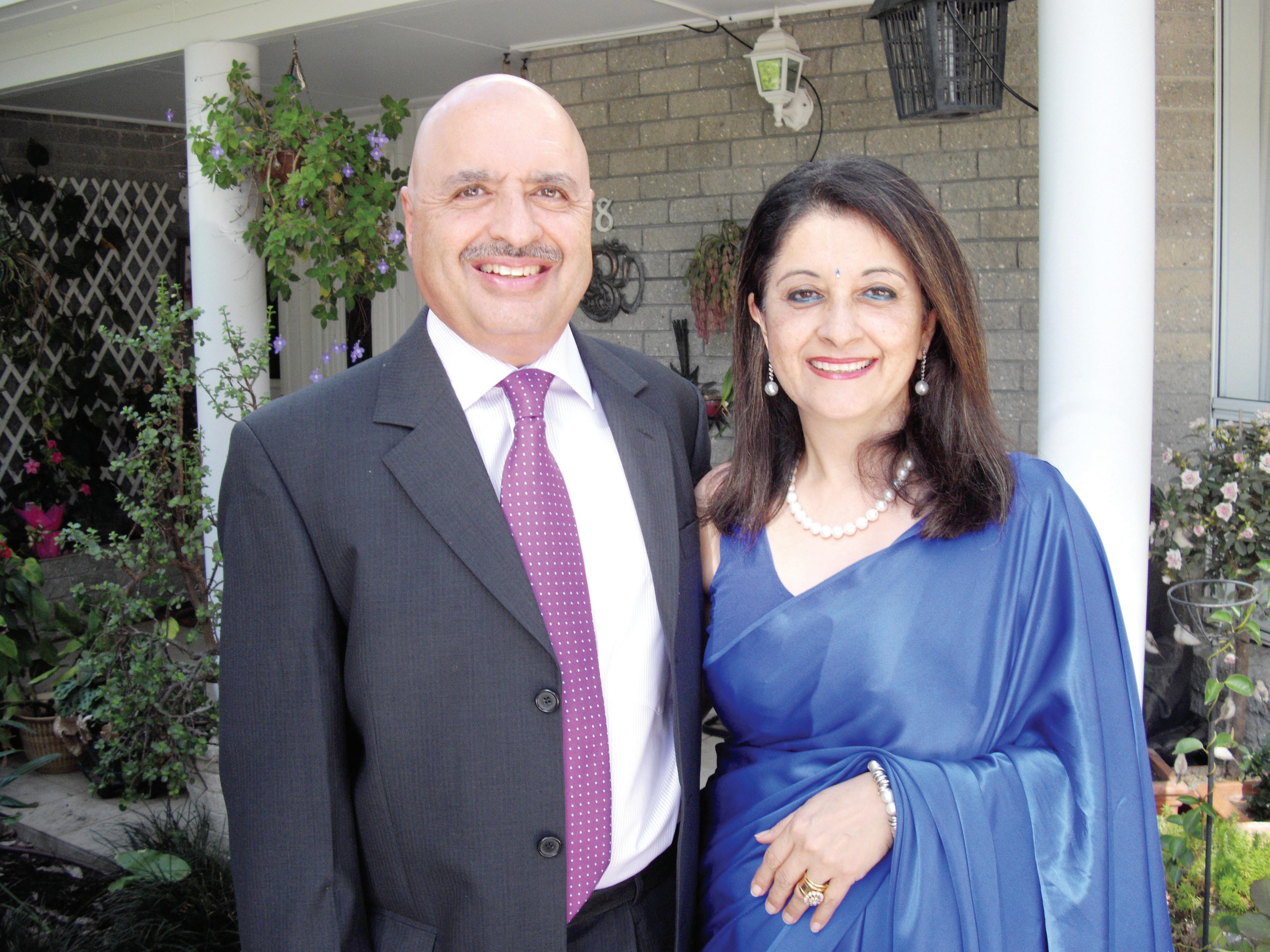


 BY HAsNAiN ZAHEER
BY HAsNAiN ZAHEER
Technology
entrepreneurship is red hot today. Recent wild success stories of new ventures in websites and mobile apps especially in SoLoMo (made from the first two letters of social media, local and mobile) has made ‘start-up’ a desirable term. This is equally the case in Silicon Valley, Australia and India.
And why not? The previous five years has seen a 24 year old hit pay dirt with a venture worth billions of dollars. We are talking about Mark Zuckerberg, the founder of Facebook.
A company that was less than one year old and with no revenue was sold for a billion dollars and spare change. This was Instagram, which allows its users to share photos via their mobile.
And Redbus.in, a Bangalore based start-up that helps customers book their bus travel was recently sold for $100 million.
Suddenly, entrepreneurship and start-ups are no longer taboo in the conservative Australian job market, which has traditionally rewarded a consistent career ladder.
There are start-up co-working spaces galore. Fishburners in Ultimo that hosts more than 100 start-ups, is one of the leading ones, but there are several more in Sydney, Melbourne and Brisbane. Lawyers and consultants are bending over backwards to provide free services to entrepreneurs to get a piece of the action. And investment in start-up companies is picking up.
One long term, consistent player in this space is TIE
Sydney. Originally founded as The Indus Entrepreneurs (TIE) by technology entrepreneurs of Indian origin in America’s Silicon Valley, TIE has now expanded to 57 locations, including Sydney and Melbourne.
TIE has now broadened its scope to being a network of entrepreneurs, mentors, investors and other players in the entrepreneurship ecosystem. It is now a mainstream network, no longer an Indian professional club, although one can still discern active participation by Indian business people.
TIE Sydney, located at http:// sydney.tie.org is active in Sydney’s start-up environment since 2001. It organises free and paid meetings and sessions on starting up, scaling and exiting businesses, mentoring sessions and pitching competitions, but its central event is its annual conference, TIECON.
In TIECON 2013, the theme was Go Asia. More than 250 delegates were exposed to a diverse range of ideas and insights on opportunities in Asia and how to tap those opportunities for their start-up’s growth. One of the highlights of the introductory panel sessions were Dr. Jana Mathews describing the working of her 13 weeks accelerator that she runs in Adelaide. ANZ Innovyz selects start-up teams several times a year, puts them through an intense mentoring programme during which time they work on their product-market fit, customer validation, product development and scaling issues. The start-up team doesn’t pay anything for this service; rather, they are paid $20,000 during this period.
Alfred Lo manages Optus Innov8 Seed Programme, a corporate venture arm of Optus that invests in Australian technology ventures. He mentioned start-up momentum is building up in Australia
and throughout Asia.
Julian Tol, who is an Australian based in Singapore described his experiences of building the company in Asia while raising capital locally in Australia.
Ahmed Haider, a Western Sydney-sider, UTS boy, is a cofounder of Zookal, an educational technology start-up that enables students to rent textbooks among other services. He recounted his experiences of raising capital in Silicon Valley. He went against the traditional wisdom of raising capital in the home market and mentioned that exceptions can be made.
After all, start-ups are created because their founders wanted to do something different and it’s acceptable to go against traditional wisdom.
The rest of the conference was divided into three areas of Asia where Australian start-ups can go to explore opportunities, India, China and South East Asia. Panelists in these sessions were entrepreneurs and executives who had experience of setting up or running businesses in these regions. A few highlights from the India related sessions were, Joshua Mackenzie, CEO of Development Beyond Learning emphasising that family is everything. He recommended to develop
informal networks of personal and family networks in India.

Other tips:
• Make use of the Indian consulate in Sydney which provided a great service to one of the panellists.
• Almost all panellists realised the need for due diligence when assessing partners and their promises.
• Know your customer, whether it is the industry, individuals and the legal environment.
These panel sessions were followed by a pitching session in which start-up companies presented their business to the audience. One of the highlights was a Bangalore based start-up Lumos, that pitched via a video call. Lumos makes bags that have solar panels and helps the bag make its own electricity to charge phones and other devices.
Australia’s start-up eco-system is highly US and Silicon Valley focused. TIECON 2013 helped Australian entrepreneurs realise the nearer-home opportunities in China, India and South-east Asia.
Indian Link would like to thank TIE office bearers and volunteers for their assistance, particularly Dilip Rao, Manishi Dave and Ambika Malvia.
lawyers and consultants are bending over backwards to provide free services to entrepreneurs to get a piece of the action
More than 250 delegates were exposed to a diverse range of ideas and insights on opportunities in Asia and how to tap those opportunities for their start-up’s growth


it was that time of the year between Dusshehra and Diwali, that the preDiwali celebrations were held for the second consecutive year at Martin Place in Sydney’s CBD. The October 17 celebrations included the India Calling initiative, loads of stage performances, flash mob dances, attractive and colourful traditional costume stalls, henna, rangoli and other art stalls, and naturally, Indian food stalls. The day-long event was organised by the Hindi Council of Australia (HCA), and included more than 300 performers, participants and volunteers. Over 6,000 people visited through the course of the day.

The event kicked off at mid-day with a warm welcome and the Australian and Indian national anthems. Students from Cronulla, Mascot and Ashbury Public Schools participated in the feature, and were joined by Double Bay, Canterbury, Annandale, Carlton South and Janali Public Schools.
It was amazing to see the young Cronulla Public School kids depicting the story of the Ramayana dressed as Rama, Sita, Lakshman and Hanuman. Mascot Public School students walked on the stage representing people from different Indian states, wearing Punjabi, Rajasthani, Tamil, Bengali and Kashmiri costumes. This was followed by dance performances to and Twist by the Ashbury Public School students.
(The India Calling encourages school children to learn respect for each other’s cultures, customs, language and religions, and provides them an opportunity to meet on significant days in the Indian calendar and participate in cultural activities).
The colours and energy of Martin Place during a busy working Thursday was phenomenal as people from different backgrounds walked around, curious to check out the action behind the music they must have heard through their office windows. By 12:30pm and during lunchtime, the area was jam-packed.
Of course the portly God of
Balam pichkari steps taught to an interested audience. Garba, laavni, bhangra and the inevitable popular Bollywood dance numbers followed. The dances were energising and greatly applauded by the audience, including the ‘whistlers’ amongst the crowd who had increased in number.
Meanwhile, the henna stall saw a lot of traffic with ladies and even men wanting beautiful designs applied on their hands and arms. The expertise of the

session however, was towards the end of the day when the workforce had finished their day and all sorts of city-goers were interested to join the Diwali celebration buzz! This segment was versatile, starting with classical and instrumental performances, before moving onto Bollywood and traditional fusion performances.
The garba performance by ISSO Blacktown, Tagore dance by Arpita, the presentation by the Lotus Dance School and
The other notable performances of the evening were Rhythmic Squad, a Bollywood mash up; Shiamak Group; Pallavi from CK Performing Arts; Raas garba fusion by ISSO Blacktown; dhol giddha group paniri led by Reema Randhawa; and dhol beats dance floor with DJ Dimple.
The competent MCs for this session were Australian and Bollywood actor Nick Brown, and Hindu Council members Emie Roy and Leah Briars.
The cultural programs were
managed by Anita Sharma and Sanjay Khanna, and the event was well organised by Sanjeev Bhakri, Raman Bhalla, Bhupinder Chhabra under the sincere guidance of the Chairman of the Council, Prof Nihal Agar. Distinguished guests included the Indian High Commissioner Biren Nanda; Consul General Arun Goel; MP Phillip Ruddock; MP Craig Kelly; MLC David Clarke; MP John Robertson; MP Matt Kean; MP Geoff Lee; Councillor Gurdip Singh; and ex-Councillor Dilip Chopra.
The event was well received as indicated by the number of visitors who attended the event, and it has been hailed as a great success. Many visitors left all eager to attend the Hindi Council Diwali fair, to be held on a much grander scale, only a few days later.

To the delight of the workforce, Martin Place was transformed into a riot of music, festivity, colour and celebrationBY RAJNi ANANd LUTHRA
he message of light dispelling darkness can be found in many religions,” Victor Dominello, NSW Minister for Citizenship and Communities and Minister for Aboriginal Affairs said recently, “but no other culture celebrates this with as much energy as the Hindus!”
He was speaking at the 15th Deepavali Mela organised by the Hindu Council of Australia at the Sydney Olympic Park in late October.
Minister Dominello couldn’t have said it better. This year’s Deepavali had it allentertainment, fun and food, catching up with friends, Raavan dehan, and to round off, some superb pyrotechnics.
The atmosphere began with cheerful anticipation of a busy day, with a riot of colours assaulting the senses through many brightly dressed attendees in traditional attire, coloured stalls sporting various wares and services, and the gaiety and camaraderie that is so symbolic of Diwali. The mela drew in some 15,000 people, much more than the UIA sponsored fair only months ago, and delivered in every respect. By the end of the day, the crowd was happy and
home away from home.
Both Victor Dominello and Labor veteran Chris Bowen impressed with their speeches on the occasion, also with their knowledge of the festival and the community they were addressing.
TChris Bowen recalled his first Festival of Lights seventeen years ago, when he attended a Diwali celebration at Fairfield as mayor.
Both splattered their speeches with ‘namastes’, ‘shukriyas’ and ‘dhanyavaads’, in what can only be viewed as sharing the spirit of the season.
Hindu Council head Nihal Agar’s address clearly brought out his appreciation for the volunteers, whose efforts were indeed obvious for all to see.
Prof Agar’s dedication to the cause has been so exemplary, that he could possibly be called ‘Mr Deepawali’. Putting in many hours into this voluntary activity, he has gained the respect of the Indian community at large. To the members of the Council, he is a great leader and motivator and has instilled the same spirit of dedication within his team.
Not only did he pick his core team of organisers well, Prof Agar also ensured that they worked cohesively and efficiently. In the end, perhaps it was the clear vision espoused by the Diwali Mela committee that saw the event meet with the success that it did.
High Commissioner Biren Nanda’s speech on the other hand, sadly contained no message of
Indian community, or indeed the wider mainstream as they tackled an extreme natural disaster.
Even as bushfires raged in the nearby Blue Mountains, the Olympic Park event saw the launch of the Hindu Climate Action Kit. The Kit has been developed jointly by the Hindu Council of Australia and ARRCC (Australian Religious Response to Climate Change), a multi-faith organisation promoting actions to reduce eco-footprint amongst the faith communities of all major religions.

The HCA’s Vijai Singhal who helped develop the kit, said, “The current extreme weather conditions are a very timely reminder to all of us to take action to reduce our eco-footprint. From Hindu teachings and prayers to easy-to-understand science and improving energy efficiency, from ideas for nurturing a sense of connection with Mother Nature to advocacy, this kit will empower us in Greening our temple worship.” ARRCC President Thea Ormerod helped launch the kit at the event.
There were some murmurings that perhaps the fireworks should be cancelled as a mark of respect for those affected by the bushfire, following the Chinese community that cancelled its own fireworks the same week. Raman Bhalla from the organising team revealed to Indian Link that indeed the idea was considered, but the decision was finally taken after some deliberation to keep them on.
if the fireworks will be on,” he said. “The burning of Raavan is an essential element of the Diwali tradition. However our thoughts are definitely with those affected, as well as with those fighting the tragedy, and so we have decided to push our fundraising appeal very, very strongly.”
Indeed MC Manbeer Kohli passionately urged everyone on a regular basis, to do their bit.
On stage, the events ranged from cultural acts such as songs and dances both traditional and contemporary, to missives from various charities such as Transplant Australia. The standout numbers were crooners Jaspreet Grover and Priyanka Bhanushali, the Shiamak Davar dancers, and out on the grass, the Bollywood flash mob.
Meanwhile, stalls in the outer field did brisk business. The food stalls probably saw half hour long waits at any given time, with stall holders such as the sugarcane juice rushing to refill supplies at regular intervals. (Hey, was that a fight that broke out at one of the foodie stalls? We couldn’t tell from the distance!) The ‘dharmic’ stall selling religious samagri was also busy, as expected, and everyone dropped by at the makeshift mandir to say quiet prayer to Lakshmi and Ganesh, the gods of the season.
The Western Union-sponsored Bollywood dance competition was an absolute hit, with some pretty good entrants strutting their stuff.
The Ministry of Bhangra (MOB) were as forceful as ever as they stunned the audience with their

clear winners wherever they go, this time round they saw some stiff competition from the new and innovative Shiamak Davar dance troupe. MOB ended up placing first, with Shiamak Davar a close second. Thank you MOB and Shiamak dancers, for raising the level of entertainment at Indian community functions! And keep up that spirit of competition because it makes it all the more enjoyable for the audience (who are sick by now of the amateur fare to which they are regularly treated).
The Telstra-sponsored Rangoli competition was a nice touch too: it added that ‘back home’ feel commendably, and no doubt inspired many to make plans for participation next year.
Overlooking it all, the big baddy Raavan stood witness to the celebrations, taking it all in with his ten heads, and weathering the hot sun in anticipation of his own fiery end. He may have looked pretty docile, but to the Hindus gathered there, he was evil personified! Come dusk, he was set alight, as revellers cheered. All the evil in the world had been symbolically brought to an end; the world was rid of all negative energies. As if to rejoice, the fireworks display came on, and as the sky glimmered and shimmered with a million lights, to the Hindus it marked the beginning of a shiny and hope-filled New Year.
More pics on page 30-31
Icelebrations galore this Diwali, perhaps more so than in previous years. What is particularly exciting is the initiative being taken by local communities as well as businesses to celebrate the Festival of Lights. At the time of going to print, a variety of events have given Sydneysiders an opportunity to get together in the spirit of Diwali. Even though the mega events by the Hindu Council of Australia (at Martin Place and at Sydney Olympic Park) are done, it looks as though the desire for all things Diwali is not quenched yet - there are still plenty more parties to come if you’re interested.
Here are reports from some of the celebrations around the community.
New association Strathfield
Australians of Indian SubContinental Heritage Inc. (SAISH), have set a high standard in bringing the local community together to meet and greet each other on the happy occasion of Diwali. Describing the organisation, President Prabhat Sinha says, “We are a nonsectarian, non-partisan group established to play a pro-active and pivotal role in the involvement of Indian sub-continental community towards integration with mainstream Australia”.


Showcasing the cultural heritage of the Indian sub-continent, its maiden efforts were split in two parts on Sunday 20th October. At midday, a three-hour cultural show

was organised at the Strathfield Town Square with dances and food stalls. Later the party shifted to the Strathfield Town Hall where the festivities continued. A packed hall of over 600 people enjoyed an evening of meeting friends and making new ones. There was a splattering of politicians from both sides of politics spreading the cheer. But most significantly Prabhat Sinha and his team did a wonderful job in taking the spirit of Diwali to the ‘burbs.
Goddess Laxmi plays an important role in the celebrations during Diwali and so it comes as no surprise that the banks want to pay their own obeisance! Westpac has long shown an affinity for the Indian community down under and have worked hard to win the hearts and minds of its members and create wealth for them. To celebrate Diwali, Westpac entertained its customers at an evening of pageantry at the Holiday Inn at Parramatta. Nearly 300 people were in attendance including a large number of Westpac staff. The event was compered by Suraj Kapila, who received the news that evening of
his promotion to branch manager. A welcome Diwali gift no doubt. Special speaker for the evening was General Manager of Premium Services Damien MacRae who spoke of the strong connection of Westpac with the Indian migrant community and the bank’s determination to provide superior services to this client base. After the formal part of the evening the dance floor opened up and a good part of Friday night was spent dancing away to Bollywood songs as the bankers took their clients around for a dance. Diwali does help foster some interesting relationships indeed.
It was a warm and fuzzy affair at the Shaam-e-Diwali organised by the Federation of Australian Indian Associations (FAIA) on 27 Oct. The Dundas Community Centre played host to about 200 community members who gathered to exchange early Diwali wishes. It was a microcosm of the early ‘90s as most attendees were early migrants, and the mood certainly reflected the warmth of a close-knit community. Everyone contributed towards the event either in terms of preparing cultural items for the entertainment, or even the food (indeed, President Neera Srivastava herself cooked the gulab jamuns for dessert).
While it is hoped that the FAIA is reaching out to and attracting
newer Indian settlers in others aspects of its wider endeavours, on this occasion, the celebration was informal and family-like, perhaps deliberately designed to reflect the spirit of community at this festive time.
“Our intent has been to share the Diwali spirit with others,” Neera Srivastava told Indian Link “We have Australian, Thai, Ukrainian, Malyasian and other guests present today,” Premila Singh pointed out.
Vish Vishwanathan put in a note to remember the devastating bushfires and encouraged all to donate to the organisation’s benevolent fund to help those affected.



 BY ASTHA SINGH
BY ASTHA SINGH

The Symposium on Racism and Women held on October 17 at the NSW Parliament theaterette, proved an excellent forum for members of the community and organisations to express concerns about gender and racial discrimination against women. Government representatives, politicians and academicians addressed these issues, and positive outcomes in advocating improvement in government policies and programs to condemn racism against women were achieved. The forum was co-sponsored by the Immigrant Women’s Speakout Association of NSW (IWSA) and the Australian Human Rights Commission (AHRC). The full house marked an important milestone in women empowerment strategies of NSW and Australia.
Gender equality in Australia implies a society in which women and men enjoy the same opportunities, outcomes, rights and obligations in all spheres of life. Equality between the two genders exists when both have equal opportunities for financial independence through work or through setting up businesses, enjoy equal access to education and the opportunity to develop personal ambitions. The forum addressed a critical aspect of gender discrimination, which is the empowerment of women, with a focus on identifying and redressing racism issues and discussing ideas about how women could achieve autonomy to manage their own lives.
The forum was well-attended and included Federal and State Government politicians such as Pru Goward, Minister for Women; Sophie Cotsis, Shadow Minister for Women, and various heads of ethnic organisations such as the Federation of Ethnic Communities Council, the Ethnic Communities Council and the Community Relations Commission. Speeches were given by Senator Concetta Fierravanti-Wells, representing Prime Minister Tony Abbott, also Parliamentary Secretary to the Minister for Social Services, with a special responsibility for Multicultural Affairs and Settlement Services; and Victor Dominello, NSW Minister for Citizen and Communities and Minister for Aboriginal Affairs, also the member for Ryde, who also represented the Premier of
NSW. Mr Dominello hosted the symposium on behalf of the NSW Government. NSW Deputy Leader of the Opposition and Member for Canterbury Linda Burney represented the NSW Opposition Leader, and also spoke at the forum. Speeches were also delivered by Gillian Triggs, President Australian Human Rights Commission; Stepan Kerkyasharian, President Anti-Discrimination Board; and Pallavi Sinha, Chairperson of the Immigrant Women’s Speakout Association (IWSA).
Participants of the symposium reflected on the current measures in making better strategies in responding and assisting victims of racial vilification and attacks.
In her introductory speech Ms Sinha said, “In relation to women, 80% of women who approach IWSA as clients have reported that they experienced racism. When a woman experiences racism, it doubles the discrimination because of the fact that she is from a different race, cultural background and age-group. Sometimes women are more vulnerable because they don’t know their rights or they don’t have the confidence to stand up for themselves. Racism against women affects individuals and Australian society adversely”. As Chairperson of IWSA, Ms Sinha admitted that she has seen women who have suffered a loss of selfesteem, have felt stigmatised and isolated which had a negative effect on their physical, emotional and mental health and their participation in a household or at their workplace, which can have a negative effect on productivity and the economy.
“I think it’s very important that more research is done in this area and that the government adopt a gender perspective in the design, delivery and evaluation of all policies and programs,” she stated.
“Unfortunately, immigrant and refugee women suffer a ‘triple whammy’ effect when racially vilified. It’s a combination of factors. It’s both gender (because) they’re women. It’s race because of their particular racial background, but it’s also more nuanced in that we have to think of the cultural and linguistic backgrounds which add to those disadvantages,” stated Guillian Triggs. Addressing women’s issues also requires recognising that women are a diverse group, in the roles they play as well as in characteristics such as age, social status, urban or rural orientation and educational attainment.

“Racism in any form should be condemned as it is damaging and systemic. Migrant women face many problems around employment and engagement in society, they don’t have job search networks and they also need gender education along with awareness about facilitation of work placements,” she added.
Summing up, Ms Triggs said, “Migration discrimination cuts across various other types of discriminations like asylum seekers discrimination, race, sex, age and ethnicity discrimination”.
Concetta FierravantiWells summed up the racial discrimination act of 1975 and mentioned some initiatives taken by the Government in advocating gender and race equality like Harmony day on March 21 and endorsement of intercultural and international events in Australia by the government.
Victor Dominello emphasised that intensity of discrimination and racial activities is usually precipitated by fear and ignorance by the victims in most cases, minorities. He succinctly stated that inter-religion, inter-racial and inter-community marriages are an antidote to racism.
Stepan Kerkyasharian’s speech was the most informative and factual. He spoke about the root causes of discrimination and about his own experiences about resolving issues around racism and discrimination. He once again boldly explained the definitions of the two, and explained the laws around the prevalence of racism and discrimination. He recommended that different boards across institutions and government should perform their roles in facilitating prevention of such acts from occurring through print media, online communication, magazines, newsletters and also set up an effective enquiry and complaint service.
Linda Burney, the first Aboriginal Australian elected to the NSW Parliament emphatically stated that sexual violence is regularly linked to racism for indigenous women, often within very small towns.
“It makes you feel sick, racism,” Ms Burney said. “For anyone who says racism isn’t an issue in this country and that people should just get on with it, we are a great multicultural society, there is no two ways about it, but let’s not pretend”.
Ms Sinha also added that legislation needs to be toughened to give women more access to help, and that it is a problem that has a disproportionately negative effect on immigrant women.
The serious mood lightened within the forum with a vibrant and colourful display by Asian women playing the drums, and a flash mob by migrant women.
Following this, two women participants shared stories of racism they experienced and the Q&A session saw active participation between attendees and guest speakers.
As an outcome of the Symposium, IWSA will be
working with the AHRC and ADB to prepare recommendations about migrant women facing racism that will be presented to the State and Federal Governments.
The circumstances surrounding gender discrimination and racism were openly discussed in a wide-reaching forum
“I think it’s important that the government adopt a gender perspective in the design, delivery and evaluation of all policies and programs”
Pallavi Sinha




(ABN- 58 161 720 501)
For upcoming ENS and RSMS changes from July 2013 Call now at 0433 986 780 0421 119 628
i) Advice on Migration pathways
ii) General Skilled Migrationspecialist
iii) Student Visas( new and extension)
iv) State Sponsored Visas / ENS / RSMS / 457
v) Business Migration
vi) Partner and Family Migration specialist

vii) Admission in Australian Colleges and Universities
• MRT Review procedures in Australia
• OCI / POI / Indian Passport Application / Renewal
We also specialize in
Home / Commercial Loans (MFAA Certified) specialist
Contact:
Sonal Agrawal Syed Mohiuddin (JP) Ex-Visa officer


MARN:1169617, MMIA:5385 MARN:1171248, MMIA: 1021, MFAA:54385
Level 2, Suite 8A, 48 Macquarie Street, Parramatta, Australia 2150

PH (02) 86775161, FAX: (02) 98916314

Email: contactus@completemigrationservices.com.au

(We Speak English, Hindi, Marathi, Urdu, Telugu)
For quick visa assessment fill the online visa assessment form on www.completemigrationservices.com.au
We help you achieve a better life and pursue your dreams
The Reserve Bank of India (RBI) recently hiked a key policy interest rate by 0.25 percent in less than two months to contain inflation, but eased some rupee support measures. The move would make home, auto and other loans costlier.
In its second quarter review of the monetary policy for 2013-14, the RBI hiked repo rate by 25 basis points or 0.25 percent to 7.75 percent. Repurchase or repo rate is the rate of interest that banks pay when they borrow money from the central bank to meet their short-term funds requirement.
This is the second increase in the policy rate in less than two months. The central bank hiked the repo rate by 0.25 percent in its previous review announced Sep 20.
Rate sensitive stocks rallied following the RBI’s rate decision, leading to 359 points jump in the benchmark Sensex of the Bombay Stock Exchange. Snapping five sessions of losses, Sensex ended the day on Oct 29 at 20,929.01 points, just 75 points away from its record closing high of 21,004 points hit in 2008.
Taking a cue from the stability in the currency markets, the RBI rolled back some of the measures put in place to support the rupee. The Marginal Standing Facility (MSF) rate is reduced by 0.25 percent to 8.75 percent. The move will ease liquidity in the banking system. MSF is a window for banks to borrow from the RBI.
“With the reduction of the MSF rate and the increase in the repo rate in this review, the process of re-aligning the interest rate corridor to normal monetary policy operations is now complete,” RBI Governor Raghuram G. Rajan said in the policy statement.
The RBI generally maintained a 100 basis points gap between repo and MSF rate. But this gap was altered recently to support the battered rupee. With the changes now the gap is back to the usual 100 basis points.
Rajan said the policy stance and measures in the review were intended to curb mounting inflationary pressures and manage inflation expectations in a situation of weak growth.
Annual wholesale price index-based inflation jumped to a seven-month-high of 6.46 percent in September, while consumer price index-based inflation was recorded at 9.84 percent, largely due to higher food and fuel prices.
Rajan, who took charge as the RBI governor Sep 4, said both wholesale and consumer price inflation are likely to remain elevated in the months ahead, warranting an appropriate policy response.
“The Reserve Bank will closely monitor inflation risk while being mindful of the evolving growth dynamics,” he said.
Rajan’s statement gives indication that the RBI would hike rates again if inflation remained high.
“The message from RBI is clear, as long as inflation is around, asking for a rate cut would remain a wish list,” said Rana Kapoor, president of industry body Assocham.
Kapoor, who is also managing director of Yes Bank, said: “All efforts must be made through coordinated efforts by the centre, states and the RBI to fight price rise so that the economy can be brought back to the growth trajectory”.
The RBI has cut economic growth forecast for the current financial year to 5 percent from its earlier projection of 5.5 percent.
“While industrial activity has weakened, strengthening export growth, signs of revival in some services along with the expected pick-up in agriculture could increase the real GDP growth from 4.4 percent in the first quarter to a central estimate of 5 percent for the year as a whole,” Rajan said.
Reacting to the RBI move, the Confederation of Indian Industry (CII) said the hike in repo rate has come as a disappointment to industry especially as the investment climate continues to be weak and growth outlook remains muted.
“The RBI could have refrained from effecting a hike in repo rate as industry is already reeling under pressures of high cost of capital and low availability in a tight liquidity situation,” CII said.
A security official caught hold of a man scurrying away from a Patna railway station toilet where a blast took place on October 27. And the terror suspect who tried to bluff his way out has turned out to be a big catch.
Mohammad Imtiaz Ansari, the main accused in the serial blasts in Patna, was caught by a Government Railway Police (GRP) official when he suspected
something was amiss with the youth trying to flee after coming out of toilet following a bomb explosion.
Senior officials have declined to name the brave GRP official for security reasons as also because it would endanger him.
“Imtiaz was forced to flee after a bomb exploded when another terror suspect Ainul alias Tarique was trying to fit or fix a timer in a bomb at a Patna junction toilet,” a senior GRP official at Patna junction said.
ADG (Special Branch) Rajesh Chandra said Imtiaz tried to act smart when the GRP official first pounced upon him and nabbed him. “He said he was a tailor (darzi) and he had to go to Kalyanpur in Motihari. But there is no place called Kalyanpur in Motihari. In fact, Kalyanpur is in Samastipur district,” Chandra said.
Police recovered a piece of paper from Imtiaz’s pocket, which had seven phone numbers and they recovered his mobile phone too.
Additional Director General (Rail) P.N. Rai described it as a big catch.
Imtiaz confessed that he along with six people was divided into three groups with specific assignments to carry out the blasts. He admitted that all the bombs were planted Sunday morning Oct 27 after 9 a.m.
“Imtiaz told police that he along with another terror suspect was given the task of planting bombs at the Patna junction toilet and other adjoining places, and two other groups were asked by Tahseen Akhtar to plant bombs on two sides of Gandhi Maidan, where Modi was to address the rally,” he said.
Tahseen is an activist-leader of the banned outfit Indian Mujahideen, and is the brain behind several blasts now.
Six of the seven blasts took place in and around Gandhi Maidan before Bharatiya Janata Party’s prime ministerial candidate Narendra Modi was to address a rally. Six people were killed and 83 were injured in these serial blasts.
Imtiaz told sleuths that all of them left Ranchi by a bus on the night of October 26 and reached Mithapur bus stand, nearly 300 metres from Patna junction around 6am on Sunday morning.
Chandra said the terrorists formed three groups that left for different destinations, including Patna railway junction, with six bombs each, made of 8-9-inch pipes with explosives filled inside.
Bihar Police have decided to reward
the GRP official who caught Mohammad Imtiaz Ansari.
Additional Director General (Rail) P.N. Rai said the GRP official will be rewarded for his courageous action.
Bihar Police chief Abhyanand has recommended Rs.25,000 prize for the brave GRP official, Rai said. He, however, refused to name the GRP official on security grounds.
He said Imtiaz was a big catch as that will help to crack the case of serial blasts in Patna.
“Terrorist Kasab was caught during Mumbai terror attack. More or less similarly, Imtiaz was caught by a GRP official,” Rai said.
Officials at police headquarters here said that state government is likely to announce a bigger prize for the GRP official.
The first of the low-intensity blasts ripped through a toilet at around 10am at the newly-built Platform 10 of the Patna railway station in the heart of the city.
After an hour, by which time Modi had reached Patna but not the rally ground, six explosions took place, four inside the Gandhi Maidan, and two around it.
The Patna railway station is located two-three km from the sprawling Gandhi Maidan.
Many would rub their eyes as India, the world’s largest arms importer, for the first time showcases an array of its weapons and equipment for export at an international exhibition in South Korea soon, signalling its intention to be a player in the global defence bazaar.

At the Aerospace and Defence Exhibition (ADEX-2013) in the South Korean capital Seoul, the indigenous defence systems will draw the world’s attention to the country’s emerging capabilities, its strength and expertise in design, development and production.
On display at the six-day event which began Oct 29 will be state-of-the art weapon systems, platforms, sensors, communication systems and equipment designed and developed by the Defence Research & Development Organisation (DRDO) along with its production partners like Tata Power and state-run Bharat Electronics.
Among these would be the Akash surface-to-air missile (SAM), Tejas Light Combat Aircraft (LCA), Pragati surfaceto-surface missile (SSM), an airborne early warning system (AEWS), expandable highspeed aerial target Abhayas, and other hightechnology systems like sonar, battlefield radars, and identification-friend-or-foe (IFF) systems.
“A large number of products developed by DRDO and produced by Indian industry, including those being displayed at ADEX-2013, have immense export potential,” says the DRDO.
Because of its pacifist strategic culture, India has refrained from exporting arms for several decades after independence. Its defence exports are less than two per cent of the total production of weapons and equipment.
These are mainly indigenously produced surplus small arms and light weapons supplied to some of the neighbours as a goodwill gesture.
But with the new Defence Production
Policy facilitating joint ventures with foreign direct investment (FDI), it is expected to result in increased arms exports.
Indian industries are emerging as suppliers to foreign original equipment manufacturers (OEMs), which would help build capabilities and enhance exports.
The change in thinking and policy is significant as the South Asian nation is the world’s biggest importer of weapons. According to a March report by the Stockholm International Peace Research Institute (SIPRI), India accounted for 12 percent of global arms imports during 2008-12.
DRDO chief Avinash Chander says ADEX-2013 will provide India an opportunity for building technology partnerships for research and development and export.
Over the years India has built a large defence industrial base, comprising eight defence public sector undertakings, 39 ordnance factories, a network of hightechnology research establishments under the DRDO and a number of private companies working on specific areas.
“No country can progress by importing defence material and equipment,” says Chander.
According to him, DRDO has identified areas such as ammunition for tanks and artillery guns where indigenisation would be carried out in a big way.
“We have attained total indigenisation in sonars and radars,” he said at an international symposium on ocean electronics in Kochi recently, adding that DRDO-made, ship-borne sonars would be exported to Myanmar.
In August, DRDO sold the technology to manufacture an Explosive Detection Kit in the US to an American company.
Also, of late, Indian defence services have moved to induct DRDO products into their systems. This, in turn, has sparked interest from “friendly nations” from Southeast Asia and Africa.
Africa in a few years is said to become a defence market almost at the same level with Southeast Asia and Latin America. Oxford Analytica, a global analysis firm, says Africa has reached “an expansionary period for most of its leading armies” due to “elevated security threat perceptions”.
Defence experts say India has to export weapons to sustain its nascent arms industry as the orders placed by the country’s military are small. Overseas orders are necessary to bring down the production costs.
At another level, India’s presence in ADEX-2013 signifies the growing defence cooperation and strategic partnership between the two countries.
India-South Korean defence ties began in 2005, when the two countries signed a memorandum of understanding (MoU) on defence logistics and supplies. Defence Minister A.K. Antony visited South Korea in 2010 and two MoUs on defence-related exchanges of experience, information and futuristic joint defence technology development were signed.
The same year, the two countries declared a strategic partnership.
Apart from being one of the largest FDI contributors, South Korea has become a big-ticket supplier of weapons to India. It has a wide base of companies like Hyundai, Samsung, Daewoo and Korean Aerospace, and its capabilities in missile development
and naval combat system are well acknowledged in the global arms market.
At their third Foreign Policy and Security Dialogue (FPSD) last month, India and South Korea discussed collaboration in defence production and the potential for space and nuclear cooperation.
Both also agreed to step up cooperation in the spheres of maritime and cyber security.
Defence cooperation would figure in the bilateral Joint Commission Meeting November 9 in New Delhi, ahead of the visit to India of President Park Geunhy, who would be the chief guest at the Republic Day on January 26.
The defence ministry has approved the long-pending $1.5 billion procurement of eight mine countermeasure vessels (MCMVs) from Kangnam Corp of South Korea, according to consultancy IHS Jane’s.
Kangnam’s Pusan shipyard will construct two MCMVs while Goa Shipyard Limited (GSL) will build the remaining six under a technology transfer.
During ADEX-2013, the defence ministry has planned an Indo-Korean defence meet and an industries meet.
The two countries are celebrating this year the 40th anniversary of the establishment of diplomatic relations.
Chronic psychological stress is a significant factor in the development of diabetes in Indians, a study has found. The results of the present study indicate that newlydetected diabetics display higher chronic environmental stress levels and poor stress coping capacity that could lead to insulin resistance and glucose intolerance, study author S. V. Madhu of the University College of Medical Sciences said at a press conference in New Delhi recently.
Noting diabetes constitutes a major health and economic burden in the country, he said studies in several populations show that type 2 diabetes can be best prevented by lifestyle interventions rather than drugs.
Almost 85 percent of patients with type 2 diabetes are overweight, he said, adding that despite obesity being a major driver for diabetes, 90 percent of overweight people are not aware they are overweight.
“We all know that we are sitting on a diabetes time bomb. But within this there are several issues that are not much talked about, for example, the fact that lakhs of women acquire diabetes during pregnancy, that urbanisation is a factor in the growing incidence of diabetes and that there are a series of myths still associated with diabetes in India,” said Madhu, organising chairman of Research Society for the Study of Diabetes in India (RSSDI).
With more than 63 million diabetes patients, India is second only to China in the number of people living with the ailment. With a racial predisposition to diabetes and rapidly changing lifestyles, India is certainly on course to become the diabetes capital of the world.

The US Agency for International Development (USAID) recently announced a $250,000 grant for the “Delhi Safe City - Free of Violence against Women and Girls”, to be implemented in partnership with Indian civil society organisations. The
grant will be channelised through to UN Women as part of the Global Safe Cities Initiative, a statement released in New Delhi said.
U.S. Ambassador to India Nancy J. Powell said, “The United States recognises genderbased violence as a debilitating factor impeding a woman’s active participation in any economy in the world and her ability to access resources and services. We are pleased to partner with UN Women to help promote safe cities and reduce genderbased violence, which plagues every country in the world,” she added.
A Russian delegation, led by the deputy health minister, is arriving in the state capital of Thiruvananthapuram in Kerala to have a first-hand experience of Ayurveda so that it can be promoted in their country.
The six-member delegation, led by Minister Igor Kagramanyan and Sergei Kalashnikov, chairman of the Russian parliamentary committee on health, will arrive on November 2 for a week.
They are visiting under the aegis of NGO Ayurveda Russia-India Association
to have talks with Kerala health and tourism ministers and officials.
The NGO’s representative M.R. Narayanan told IANS that the delegation would have an exposure to Ayurveda at his Poovar Island resort near Kovalam in Thiruvananthapuram. They would undergo a week-long Ayurveda rejuvenation programme at the resort.
“The department of Ayurveda, Yoga and Naturopathy, Unani, Siddha and Homoeopathy, of the central Ministry of Health and Family Welfare is coordinating the visit. They will be taking care of the promotion of Ayurveda at the government level between the two countries,” said Narayanan.
He also said that the biggest beneficiary of meeting between representatives from the two countries would be the numerous resorts that offer Ayurveda packages in the state for Russian tourists.
“Once this gets the approval, insurance companies in Russia would reimburse Ayurveda packages for them,” said Narayanan.
The visiting delegation is also expected to discuss about having short courses on Ayurveda at Russian universities. IANS

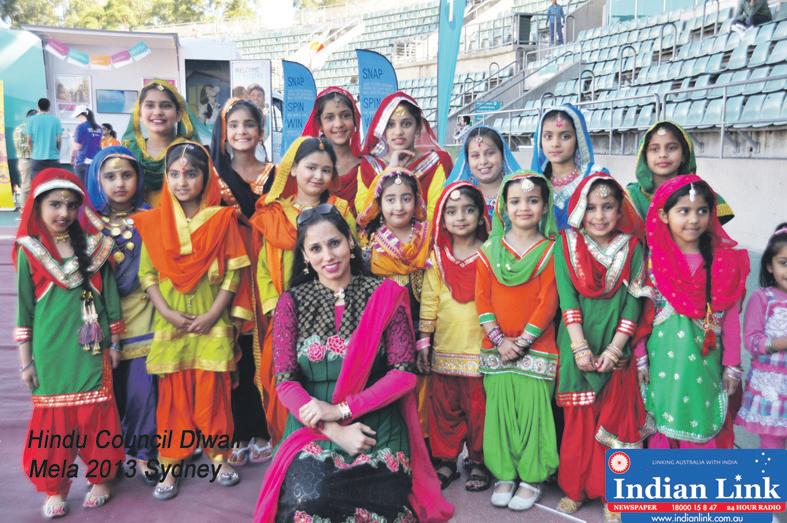

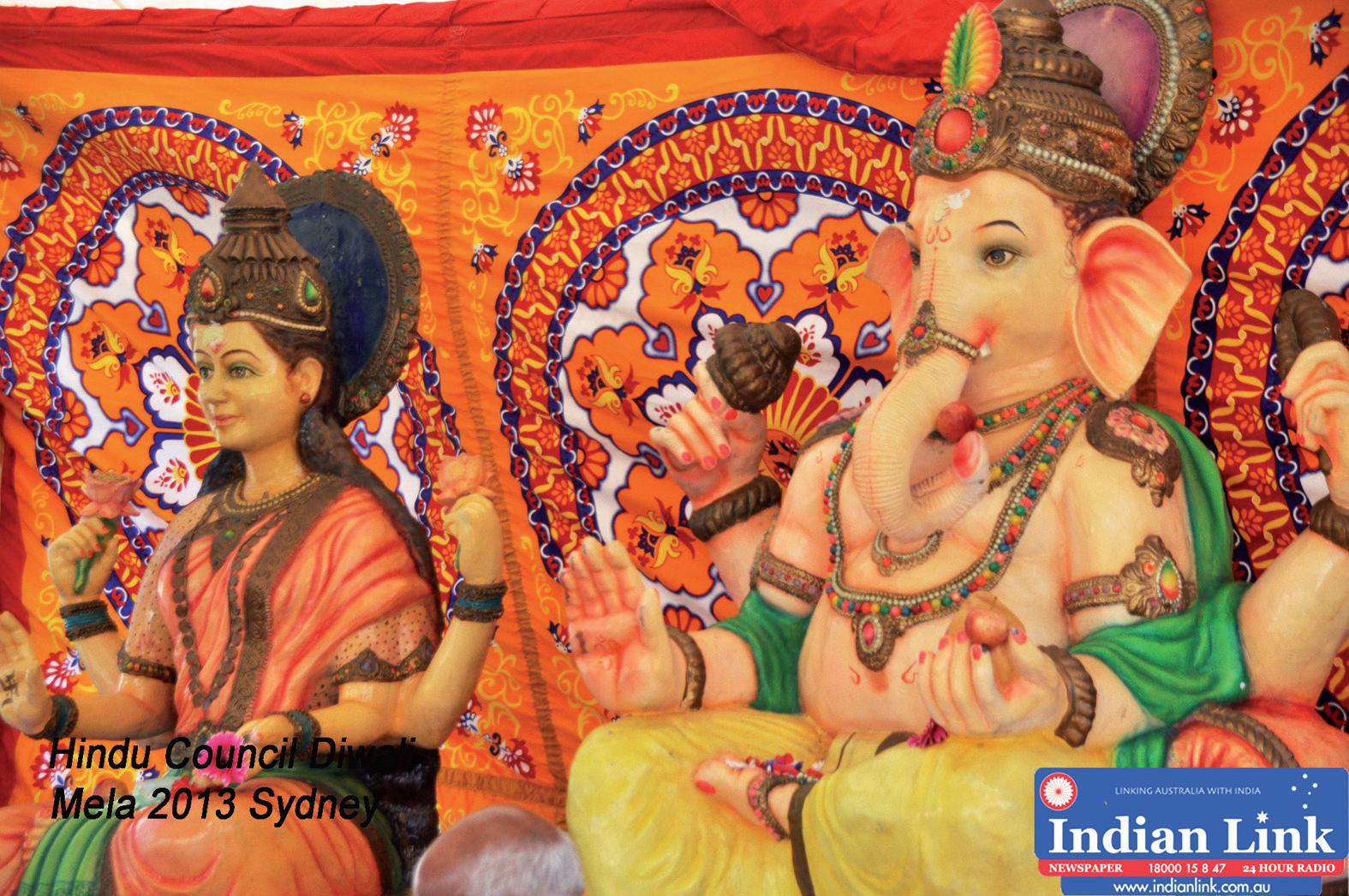
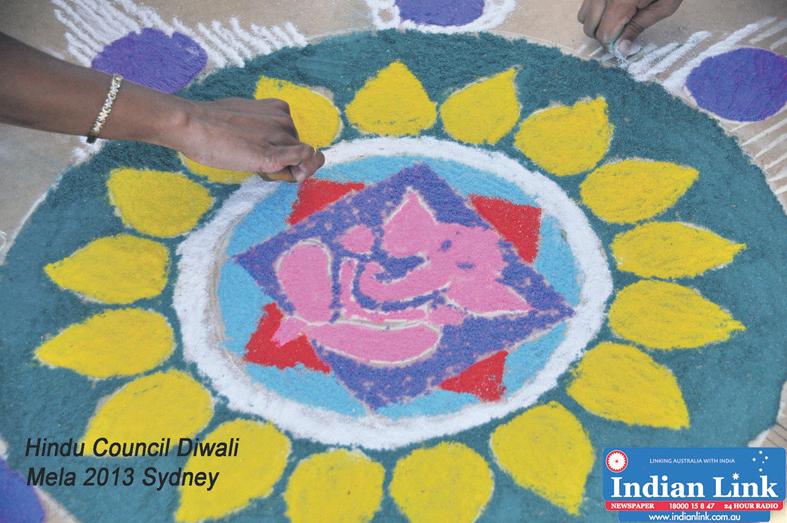
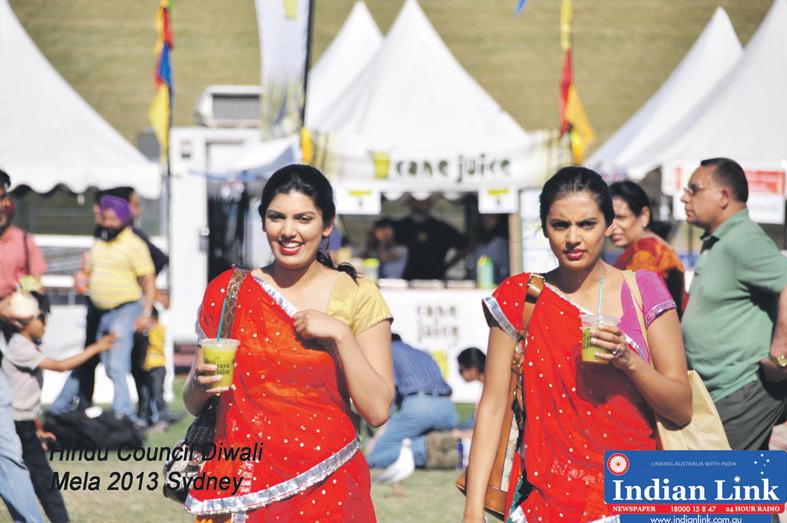
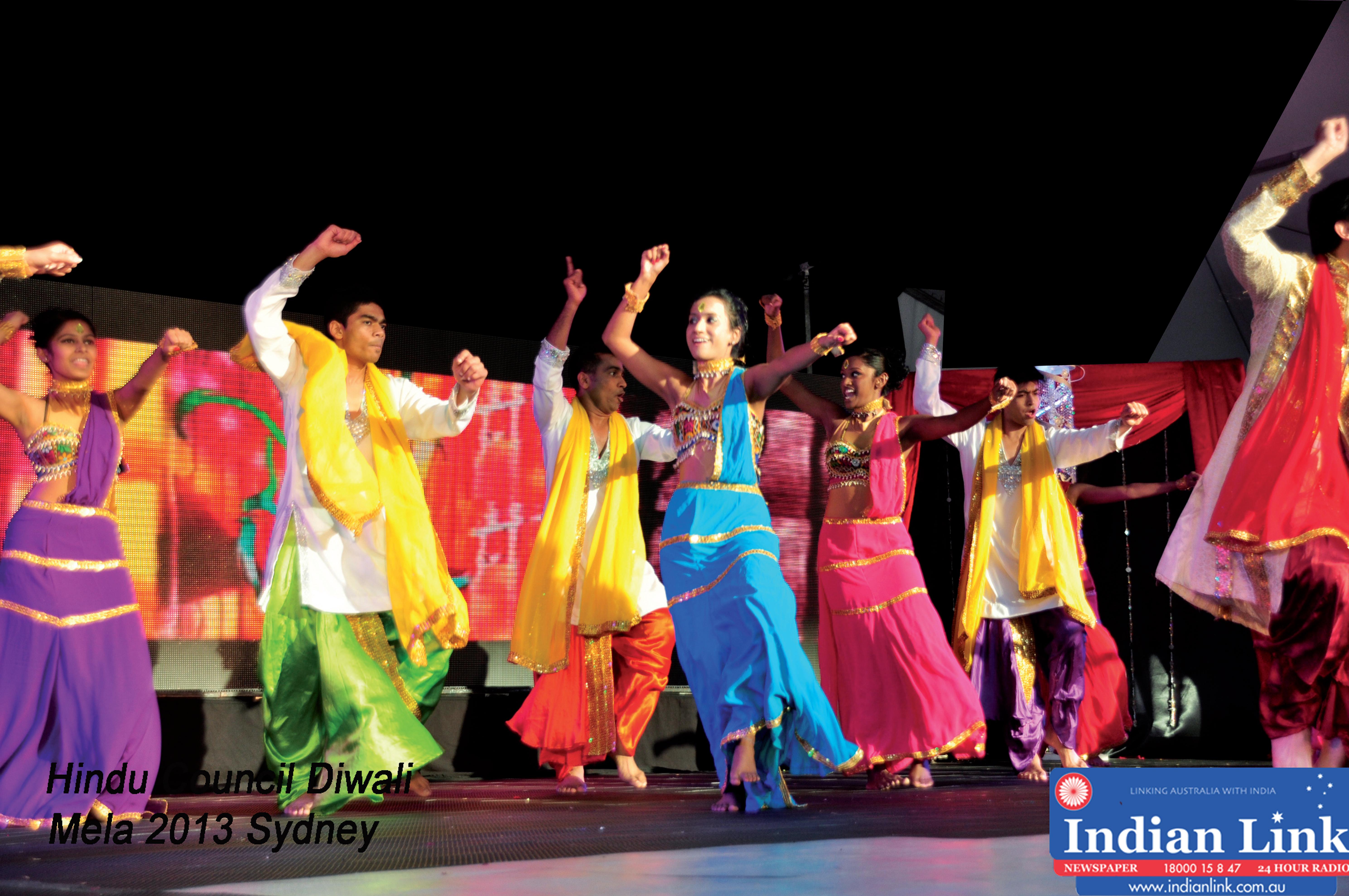 The Hindu Council of Australia’s Deepawali Fair at Sydney Olympic Park
The Hindu Council of Australia’s Deepawali Fair at Sydney Olympic Park









 Photos: Vikas Kapoor
Photos: Vikas Kapoor
Course Admissions (Australia wide), Student Visas, Work/ Sponsorship Visas (457s, RSMS, ENS), Partner Visa, Family Visa, Tribunal Appeals & Waivers, General Skilled Migration. Our clients are our best spokespeople:
• Thank you Mr Ramneek for giving right advise & act on time for our 457 Business Sponsorship. That added more value & lifted up our business by having suitable skilled staff – Renesav Pty Ltd, Sydney
• Ramneek brings in vast knowledge & experience of having worked many numbers of years in this industry to each case he takes up. This added with absolute professionalism & his responsiveness makes him one of the best in this industry. Ramneek brought all of these qualities to bear in my case to ensure that case was represented rightly with a successful outcome after stalling for almost 2 years prior to him taking the case up – Alex, IT Manager, Sydney (SC 457 to PR)
• Very courteous & attentive service. I had a few issues for my visa due to time restrictions but it was handled very professionally & without a glitch…great customer service & professionalism. Thank you for all your extended help & efforts, highly appreciated. – S.M. Athar (SC 457 visa), Windsor, NSW
• He knows exactly what is required & gets the results. I would recommend all to take his services. Thank you. – Pujan Sheth (485 to 457 Visa)
• We really appreciate Mr. Ramneek’s support for my 457 visa application. He was very organized & prompt, which we believe lead to successful & quick outcome even though we are a newly established company without much financial result. – H. Uzumasa, Penshurst, NSW
• I sincerely appreciate the time you spent reviewing my case as it became complicated due to time frames. Your advice was very helpful & gave me a new hope. Finally, I got my PR. Thank you so much for your help. – Vikas, Homebush, NSW
• Ramneek handled my sponsored migration visa with precision of a surgeon. I reckon, my application’s short processing times was owing to Ramneek’s immaculate understanding of the process, sharp eye for details in reviewing documents & presentation of the case. The first check list for submission that was customized for my professional background & situation) that Ramneek provided served as the ultimate guide in assembling the application. All my queries were answered in less than 24 hours. Such professionalism & efficiency made my visa process a breeze… highly recommended for anyone serious about his/her immigration plans. – V. Srivastava, Melbourne, VIC
• If you want excellent customer service & prompt responses to any of your questions, then TGLT is your stop. Highly professional & friendly migration agent!!
– Mrs. Michele Elkan, Shizam Enterprises Pty Ltd, Brisbane
• I had assault charges on me…he still did very good job …gave me good advice for my immigration case…And I got my P.R – R.K., Berala, NSW
• We won MRT Case. I specially thank to Ramneek Sir for helping me to sort out my visa case.
– Ankur T., Strathfield, NSW
• I believe the case was not the easiest one...my MRT appeal was approved without any problem. –Satoshi Onoue, (457 to ENS Refusal), Vaucluse, NSW
• During the whole application process, Mr. Ramneek was well organized & gave me clear instruction…I didn’t expect that easy about getting (457) visa approved but Mr. Ramneek made it lot easier for me.
- Kentaro Abe, Lane Cove North, NSW
• I would like to express my sincere thanks to Ramneek Sir for his work in getting my 457 visa…all my queries were answered in same day. – M. Singh, Merrylands, NSW
• The time I met him, I was completely confused but he resolve my problem with loads of confidence – J. Patel, 457 visa, Parramatta, NSW
• If I had to described which particular aspect of the service was well done, I cannot because I personally found every aspect of the service excellent…constant guidance & prompt communication – Thank you very much – Asha, SC 457 visa, Smithfield, NSW
• I would like to thank you for all your hard work & understanding during the process of my 885 visa. You were a pleasure to deal with – S. Aryal, Canterbury, NSW
• Thanks a lot for your support throughout my journey to PR. Firstly my sponsored visa 457 and then Employer Nomination Scheme 856. It’s been my privilege to appoint you as my migration agent. Thanks once again to help settle down in Australia.
– C. Patel, 457 to PR, Sydney, NSW

• Our company’s 457 visa would have not been possible without you in this difficult circumstances. Will recommend your service to any one any time. – Chauhan & Khamar P/L, Marrickville, NSW
• I would just like to say a big thank you for your service & support…great expertise about 457 visa requirements. – Jimmy Dattani, Strathfield (Student Visa to 457)
• Thank you so much for help. It was so quick & fast…Thank you again. – R.I., Potts Point, NSW (Student to 457 Visa)
• I really appreciate your professionalism as well as high level of commitment throughout the application process. I would without hesitation recommend to anyone to make use of your experience & comprehensive knowledge. Once again thank you so much for everything it means a lot to me & my family. –Rima Vyas, Strathfield, NSW (SC485 to PR)
• I felt helpless before I came to Mr. Ramneek but the way he responded & supported was beyond expectation. – H. Shah, Strathfield (MRT to 457 Visa)
• Thanks for handling my Partner Visa case extremely well with section 48 on our application...we got the grant of permanent visa in less than 10 days – Priyanka, Parramatta
• I am really happy with the services. He handled my case very well. – R. Kaur (Student Visa to 457), Echuca, Victoria.
• Ramneek helped me to sponsor couple of employees on 457 visa for my business...was extremely professional, always available & provided necessary info. We appreciate his work & would recommend him to anyone – Navjas Pty Ltd, North Ryde, NSW
• We applied our 457 visa with the help of Ramneek & we got our visa in less than 4 weeks.
– Bandhana Rani, (Student Visa to 457), Echuca, Victoria.
• For all your hard work you done & your timing advice, really helped me in getting my PR…thanking you from bottom of my heart – K. Singh, Glenmore Park, NSW.
• I withdrew (my) first 457 visa application…& I got it the second time with Ramneek’s help. Thank you so much. – C. Koppela, Homebush, NSW
• Ramneek, handled our matter in a very professional way…was precise with what he wanted…his knowledge is deep & accurate. I felt very comfortable.
– Shree Ram Pty Ltd, Lidcombe, NSW
• Because of his sound knowledge & experience, my 457 has been approved within 2 weeks.
I would highly recommend – R. Gaur, Bikaner
• Many thanks for acting promptly when needed. – K. Patel, 457 Sponsor, Sydney
• Thanks for the efforts you put in for this achievement – T. Kaur & N. Singh (SC 475 to PR)
• I consulted couple of agents & was very disappointed as they were very much sure that there is no 457 & I was not eligible for that. This is a special note for thanking Mr. Ramneek for helping me throughout my 457 visa process. – M. Ramakrishna Jeksani, Homebush, NSW
• We were hopeless after our initial application was mismanaged. Now I got it successfully within 4 weeks my grant which was done skilfully without any questions from case officer, Thank you Ramneek. – S. Kola (SC 457 visa to PR), Liverpool, NSW
• Has understanding of the system & very helpful. He is reachable & responds to the queries very well.
– Narendra Gupta (SC 457 to PR), Ashfield, NSW
• Everyone thought that I won’t get my 457 visa....thank you for making my application successful.
– S. Rao, Casino NSW
• You have been excellent in handling our case & all its difficulties including my daughter who has already turned 19. – K. Sanyasi (457 visa), Warwick Farm
• guidance. – Kiran Kumar Patel, Harris Park, NSW
• My 457 visa is granted. Thanks for the co-ordination, Ramneek Sir. – R.T., Cook, Westmead, NSW
• I was on a bridging visa...& I got my 457 visa within 28 days & without leaving Australia
– Amandeep Kaur, Merrylands, NSW
• Everything was well planned & Systematic. Must recommend for Immigration issues.
– H. Gandhi, 457 Visa, Merrylands, NSW
• I got my 457 work-permit (from student visa) within 4 weeks. Mr. Ramneek done his work very accurately, on time, without any failure & provides perfect guidance. I am very happy with his work & very thankful to him. – Chirag Patel, Kew, Victoria
• I was able to negotiate through the complicated process & retain a baker full time in my business. For 457 working visas, Mr. Ramneek Madahar’s services are highly recommended.
Definitely a 5 star service. – Harry, Bakery Owner, Oatley, NSW
• Ramneekbhai, thank you so much for your help. I got my 457 visa… excellent service, thanks
– Krushnakumar Patel, Parramatta, NSW
• Ramneek Sir handled my SC 190 visa & I got approval within 4 weeks of lodgement. I acknowledge my deepest thanks for his fabulous work. – A. Shah, Perth
• I would like to express my sincere thanks to Ramneek Sir for his well done work in getting my PR.
– M. Marediya, Perth, WA
• Has impressed me with the accuracy of his guidance & the time frames he gave us for our (Sponsorship/457) applications were spot on. I personally recommend anyone to use his services.
– Sana Glass Pty Ltd., Lansvale
• Thank you very much for your support while organizing the sponsorship application for our employee. We are very pleased with your work ...will confidently recommend you & your company to our business partners & friends. – Vaucluse Auto Repairs P/L., Vaucluse, NSW
• Initially, I was a bit doubtful whether my company will get the (457) sponsorship or not because mine is a small company. Thank you very much for your hard work & guidance.
– Prime Partners Pty Ltd, Casino, NSW
• Thanks for the effort taken in securing Ganga’s work (457) visa. I know it was a difficult case, much appreciated, thanks. – Dhaya Chandra Pty. Ltd., NSW
• Very satisfactory service provided by Mr. Ramneek Madahar regarding my visa complications.
– P. Singh, Ellenbrook, WA
• I am really very thankful & overjoyed... lead me through the toughest situation to final success.
– N. Singh, Mohali, India
• After 8503 (no further stay), condition waiver, my student visa was refused. Thank you Mr. Ramneek for a successful appeal at the Migration Review Tribunal without a hearing.
– P.D. Glenmore Park, NSW
• I was finally able to receive confident & correct advice in relation to my situation from Mr. Ramneek Madahar.
– G. Bastola, 457 Visa, Homebush NSW
• Thank you for your timely assistance with our restaurant sponsorship & 457 visa grant.
– CH Patel & DC Patel, Camberwell, Victoria
• Ramneek Sir has made our 457 visa 100% successful. Thank you forever.
– Shruti Shah, Merrylands, NSW
• I was a student in Australia. Mr. Ramneek helped me for a 457 visa.
– Chaudhari Prakash, Ashfield, NSW
• I was on a Bridging visa for my SC885 visa application on 110 points.
Mr. Ramneek made my 457 visa possible. – C. Patel, Merrylands, NSW
• For any complex cases, to anyone who needs help in immigration... don’t worry you are in safe hands.
– A.H., 457 Work Visa, Cronulla, NSW
• I sincerely recommend Mr. Ramneek’s services for immigration. – K.K. (457 to PR), Central Coast, NSW
• Thank you Ramneek, I wish you all the best. – S. N., GSM Visa, Egypt Mr Ramneek Madahar, thank you very much for our PR. Your efforts are appreciated & thanks for looking after my case.
– D. Patel, Business Skills, Melbourne, Victoria
• I am thankful to Ramneek for my permanent settlement in Australia.
– Vikas, GSM, Parramatta, NSW
• I applied for Regional - SC119 visa under the DRC… Mr. Madahar has handled my application very well.
– Vijaya, Bourke, NSW
• Thank you Mr. Ramneek for my ENS PR under exceptional circumstances.
– S. Kumar, Croydon (457 to PR), NSW
• Thank you for your support & help towards my ENS PR. – S. N. (457 to PR), Ingleburn, NSW.
• I am very thankful to Ramneek Sir for his help & support for my ENS residency. I had no hopes left & was planning to go back to India with my family. – K. Shah (457 to PR), South Strathfield, NSW
(Ramneek Madahar, RMA# 0428459)
For appointments, please call 02 9745 3106 or 0412 764 660 or email: enquiries@tglt.com.au
UNIT 6, 24-26 Morwick St., Strathfield, NSW 2135 (5 min. walk from Strathfield Station. Opp. Strathfield Recreational Club/Tennis Courts)
457sfor SelfEmployed ABN Holders
* Provision of complimentary advice &/or assessment for our eligible students &/or their employers is at our sole discretion.
One has the choice of letting the networking site discourage and destroy, or inspire and initiate

 BY SHAFEEN MUSTAQ
BY SHAFEEN MUSTAQ
Antoine de Saint-Exupéry’s The Little Prince has always represented for me the need to find what you are passionate about and invest in that love and passion to make your life worth living. A year that was started by me with so much fervour and passion has dwindled to an apathetic state from which I needed respite. But now I seem to have gotten it from the unlikeliest of sources, Facebook. Generally, I dislike this social networking site and here’s why.
Those carefully filtered, poised and cropped pictures hide the rain that came before the rainbow, and the crap that the unicorn leaves behind
1. It’s killing privacy. There is no such thing as the public and private sphere anymore. At a global level the CIA use it to ‘do their thing’ (YouTube CIA and Facebook). At a local level, every ‘aunty’ and ‘uncle’ is now on Facebook and wants to be your friend. And at a personal level, we are all now at risk of oversharing and becoming the annoying people we like to whinge about.

2. It’s bad for the economy. When one person (Mark Zuckerberg) earns a record $2.3 billion a year and more than half the world is dying of hunger, poverty, warfare or all three at once, it really makes you wonder at how your tacit involvement is helping this world go to ruin. It’s easy to dismiss your contribution as minute, but it is our collective minute contributions that are widening that gap between the rich and the poor, and creating a discrepancy in the division of wealth in society, a precursor to many of the issues plaguing society at large.
3. It’s a waste of time. A study found that more than a third of women check Facebook first thing in the morning. We check the site several times a day, in the middle of the night, even before we go to the bathroom in the mornings. What could possibly be happening that you are missing out on that is more important than your time to live your life yourself, rather than living vicariously through the Facebook status updates of others?
4. It causes depression
sense of rejection, despondency and fear in us that we would otherwise not experience, had we a more rounded insight into the lives of those we ‘befriend’. Facebook allows us to ‘befriend’ more than we would ever do in person, and the larger our circle of ‘friends’ becomes, the more at risk we are to falling off the proverbial Facebook cliff. We become like the lemming looking for the pot of gold in the form of that perfect Facebook status update to outdo all the ones in our newsfeed. That’s is why I dislike Facebook. But recently I went onto the site and my newsfeed educated me. It inspired me. It made me shake off my cloak of apathy and put on the cloak I always wanted to wear – the one that will let me save the world. I don’t open Facebook to read news, I have my news apps for that, but almost every second post on my newsfeed today had me moving from the couch potato position in my brain and realising that the time to act is now! A recent study shows that 78% of Facebook users get news on the social network while they are there for other purposes, such as catching up with friends or sharing photos.
While Facebook has its shortcomings, it is a tool that can be used to great benefit, should I chose to do so. Beyond my choices of deactivating my Facebook account and living in ignorance of the great wealth of information out there, or immersing myself so wholly in living through the status updates of my friends, that my own life passes me by… but there is a third option in which I recognise the tool for its capabilities and use it only in a way that is useful to me.
Facebook has now evolved from merely a stream of what my friends had for lunch and their outfits of the day, to a stream of updates on life, education, world events, politics, charity and education
Facebook users are more and more lonely. Studies find that people are depressed by the ‘Facebook world’ of their friends which show that their world is unicorns and rainbows, and leads to the inevitable comparison with one’s own life. Those carefully filtered, poised and cropped pictures hide the rain that came before the rainbow, and the crap that the unicorn leaves behind. It creates a
Facebook has now evolved from merely a stream of what my friends had for lunch and their outfits of the day, to a stream of updates on life, education, world events, politics, charity and education so that when I am on the site, I am inspired to shake off the apathy and make a change.
But how does reading articles linked on Facebook and ‘sharing’ them with friends catalyse change in the real world? One’s search for answers can be more important than the answers themselves. Go on that journey to find what you are passionate about and articulate it, pursue it, paint it into your reality and onto your Facebook page, so that one day we actualise our longing for the meaning of life by filling that hole in our hearts with love and contentment. Enjoy the journey, for sometimes it is far more telling than the answer waiting at the end.


In Britain there is a policy think tank called the Centre for the Market Reform of Education (CMRE). As can be guessed from this title, this independent body seeks to find market-based solutions to problems arising in education. The CMRE has been created in response to the British government and many other parts of the world, seeking to find improved ways to manage school and schooling, and to boost schooling outcomes. In Australia there has been much discussion recently about the Coalition’s education policy. The policy has been characterised as privatising public schools and debate has been heated.
In essence, the Coalition’s education policy seeks to give greater autonomy to public schools and to allow them a greater degree of independence, including in financial matters. Advocates who favour public schools have criticised the plan, while those who favour market-based reforms see them as sensible. However, there are several justifications

for the shift to apply marketbased reforms to mainstream public education. These are accountability, performance-based pay, localised control including parental input, improved capacity to employ and choice.
There is a general feeling that teachers, as professionals, are not accountable enough. This stems from the following observations; most teachers talk to parents only once per year at parent-teacher night. Secondly, they have a closeddoor approach to classrooms and rarely have any external parties observe their teaching. Thirdly, if a student performs poorly, it can lead to teachers labelling the student as lazy. In this way a teacher can always deflect criticism or outsource responsibility. While there has been a general raise in accountability over time, the push towards giving principals greater autonomy is on part to allow them to hold poor performing staff to account.
Related to accountability is the notion of rewarding high performing teachers with some form of flexible pay or performance-based pay. Of course, this is highly controversial
amongst teaching unions. The problem with performancebased pay is how to measure performance. How can the impact of a teacher be quantified? This is particularly difficult to measure although there are sophisticated notions of ‘value adding’ that have been developed. Value adding is premised on a base line of ability within a cohort as measured by external national tests such as NAPLAN. Future performance is then mapped against this baseline, the implication being that performance in excess of the measure must be due to schooling and the efforts of teachers.
Most parents would be familiar with parent bodies such as the P&C (Parents and Citizens) and P&F (Parents and Friends). Indeed, many parents would have had the experience that the most active parents on such bodies tended to find their children were elected into school leadership positions and won the most merit awards! One aspect of the privatisation plan espoused by the Abbott government includes a greater voice for community and parental input. The idea is that schools are within communities and are reflective of communities.
The community is a stakeholder in the school. Therefore, a greater place for representation of community interests in schools is intended to both make the schools more locally accountable and integrated, as well as more closely reflective of local needs.
The Coalition plan is to increase the level of school autonomy. Note, this does not give a school total freedom, but rather relaxes some of the rules around, for example, employment. Included on the panel for the employment of staff would be a parent representative and/or a community representative.

The problem with current staffing arrangements are that often a centralised body will reassign a teacher to a school even when the school wants to appoint a person who has been acting in a relieving capacity or as a casual over an extended time. The external appointments can be very disruptive to students and also can demoralise staff who have been acting in a position and then miss out to someone else.
The capacity to employ and therefore manage budgets better will give a principal greater flexibility to shape staff and
if renewal is required upon retirement, the cheaper, younger staff with skills reflective of contemporary teaching methods can be taken on.
It is said that the move towards a quasi-privatisation of the nature detailed here will give parents greater choice. That is, as schools take on a more localised flavour and as autonomous principals apply their vision to their school with greater freedom and fewer constraints, the difference between schools will become more marked. The best schools will be clearly evident and underperforming schools could be subject to performance management of the type currently seen in private enterprise.
The market-based reforms being promoted by the government are similar to changes made in Britain, New Zealand, the USA, France, Germany, Canada and India. There is no doubt that the private market can adjust more quickly to changing demands and will act upon a need to be accountable than the present structures can. However, there is also no hard evidence that the changes make any tangible difference to student performance.



The Nobel Prizes for 2013 have just been announced, naturally bringing to mind Stockholm in Sweden where the ceremony is held. I visited the city recently and felt that it should be called ‘Nobel Nagar’ instead of Stockholm. The only interesting places to see there are connected with the Nobel Prize, barring the ABBA museum which, of course, is very vibrant. From many on offer, we took a city tour called ‘In the Footsteps of Alfred Nobel’.
First, we were driven to view the property where the Nobel family lives, but only from outside. The compound was large and it was difficult to see the house inside. Visitors are not allowed within, as the family prefers peace and quiet. Alfred Nobel (1833–96) was a Swedish chemist and engineer who made an abundant amount of money by making dynamite. He instituted the Nobel Prize that is awarded in physics, chemistry, medicine, literature, peace and economics. Only the prize for economics is not funded by the Nobel Trust. In 2012, each prize was awarded with US$1.2 million, and this could go to an individual or a group of no more than three people.
December 10 of every year is a day of festivity in Stockholm. All the Nobel Prizes except the one for peace, are distributed on that day. The peace prize is presented in Oslo, Norway. The Swedish award ceremony takes place in the Concert Hall at about noon.
On any normal day, the building is surrounded by vendors, but its status is elevated on the awards day.
By tradition, the awardees usually stay in the Grand Hotel in Stockholm, which offers them rooms at a very low price or at no cost. Normally room rental would be US$400 a night.
The event starts with the national anthem of Sweden, while in the presence of the Queen, the King of Sweden hands over the prizes. Before each prize is presented, there is a citation. The awardee makes an acceptance speech after receiving the gold medal and certificate. Then there is a musical

interlude played by the Royal Swedish Philharmonic Orchestra. The ceremony lasts about two hours in total and following this, awardees retire to their hotel for a break. This is essential as some prize winners could even be in their 80s or 90s, or even in wheelchairs.
The same evening, the awardees and other guests gather at the City Hall for the Nobel Banquet. This impressive red brick building is visible from almost anywhere in Stockholm, and houses the office of the council of the city, which also takes pride in hosting the banquet.
The banquet itself is held in a big hall on the ground floor of the building. A large table at its centre, about 100 feet long, houses the awardees and the dignitaries. Smaller tables at right angles to this seat the others. The number of invitees are usually about 1,300. Space is at a premium, with a person clamped to the seat, making it difficult to move. There is another condition as well, you cannot get up or move away from your seat till the king finishes eating and rises. Thou shalt not even visit the restroom!

There is a strict dress code; however, the exception is for awardees attired in their national dress, which is most welcome. The food is prepared in the kitchen upstairs and brought down in lifts.
The awardees enter the hall in a procession led by the King and Queen. When the food service starts, royalty is served first, but immediately after every guest is served. The idea is that everyone should eat at the same time as the royals.
After dinner, guests gather in
the Golden Hall upstairs. The walls and the paintings in this room are clad with 18 million pieces of gold. Dancing begins and the dignitaries have a chance to socialise.
It was pointed out to us repeatedly that the King and Queen of Sweden participate in the proceedings with utmost humility, deeming it an honour to be with a handful of people who have contributed exceptionally to mankind and its welfare.
The Nobel Museum situated in the old part of the city, is all about the Nobel Prize and its winners. It is a must for anyone who respects knowledge, and is always full of students wanting to know more about science or literature.
The foyer of the museum contains portraits of the 840 prize winners, accompanied by a short write up on each just below each frame. Next comes an exhibition on peace organised by the International Peace Bureau (winner of the 1910 peace prize). Rejoice Indians, Gandhi gets a prominent position there. His words, “Earth provides enough to satisfy every man’s need, but not every man’s greed” stand
out. It is a shame that he was not awarded the globally expected peace prize in 1947/48, for which the Nobel committee has apologised profusely. Another Indian features, Vandana Shiva, an environmentalist who took on multinational companies engaged in malpractices hindering the development of countries such as India. She was awarded the Sydney Peace Prize in 2010. Another person that stands out is Albert Einstein with his words, “Peace cannot be kept by force. It can only be achieved by understanding”.
Although there is a wealth of information about the Nobel Prize winners in science and literature, there seemed no specific display for CV Raman or Rabindranath Tagore.
A big display area contains donations from awardees. Amartya Sen, who was awarded the 1998 prize in economics, donated his bicycle and the mathematics books he used as a student in India. There is the original letter that Einstein wrote to his son; the crude DNA model belonging to Linus Pauling (winner of Nobel Prizes for Chemistry
The King and Queen of Sweden participate in the proceedings with utmost humility, deeming it an honour to be with a handful of people who have contributed exceptionally to mankind and its welfare
Another person that stands out is Albert Einstein with his words, “Peace cannot be kept by force. It can only be achieved by understanding”
and Peace); and the chemical balance that Marie Curie used in her experiments. Interestingly, the Curie family, including her husband, daughter and son-in-law have bagged five Nobel prizes! Chairs in the restaurant at the museum are signed by awardees, so you may be sitting on some Nobel Laureate’s signature! We had a look underneath all, and found the signature of US President Barack Obama.
Eight Indians, CV Raman, Rabindranath Tagore, Har Govind Khorana, Mother Theresa, Subramanian Chandrasekhar, Amartya Sen, Naipaul and Venkataraman Ramakrishna have been awarded Nobel Prizes. Among these, only Raman and Tagore did their prize-worthy work in India.
Taking this trip and learning of the achievements of these Nobel Prize winners, one feels like asking, “What have I done after all? How insignificant is my life?!”




Every generation produces its own genre of music such as the Rock-&-roll generation of the late 1950s and early 1960s. In those years, another well-publicised revolution was simultaneously taking shape in Goa, on the west coast of India. It was generated by the gangs of hippies who had descended on its shores and lived in communes amidst the palm trees.
These hippies were known for their inelegant appearance and behaviour, and particularly (in the eyes of Goans) for their lack of hygiene. The three important ingredients of the original hippie culture in Goa were mantras, drugs and so-called ‘free love’.
Whilst the elderly people in Goa frowned on the behaviour of these hippies, the young were not as scandalised; they looked upon the motley lot of mostly American and West Europeans as individuals who were displaying their freedom and their revolt against materialistic Western values.
Since then, the outcome of some two decades of musical
development has resulted in the Goa psychedelic trance music of the 1980s. Today Goa trance music has moved far from its origins of hippie culture in Goa. The state does occasionally host former hippies, who are now middle-aged and ‘normal’, in a nostalgic search of the past.
Goa now hosts other foreign groups. It has become the refuge of large numbers of Israelis and Russians (each of these groups are said to number around 50,000) who have adopted a carefree lifestyle which contrasts with their troubled homelands.
Goa trance music has become an industry. Numerous albums make their appearance every month. The pictorial covers of the CDs show their Indian direction, figuring covers with highly coloured kaleidoscopic geometric shapes with Indian motifs like the universal mantra ‘Om’ and Shiva, Lord of Yoga, and his trident.
Goa trance music had, till a decade ago, acquired a low-level status and belonged to a marginal group. But the time was ripe for Goa trance recordings to be replaced by something at a higher level and to become part of the mainstream. This we saw achieved in a concert at the Sydney Opera House by Ludovico Einaudi (a closely-related Italian in-law of mine).
Einaudi is a prolific composer

he has been bestowed with the prestigious Senior Order of Merit of the Italian Republic.
At the time that Ludovico gave his Sydney concert, the packed concert hall (which seats over 2,600 people) had been totally sold out, which is rare event for a debut concert. His music was apparently known to a whole generation of young people. The manner and dress of the audience confirmed that this was no hippie show. The clothing was elegant. People sipped champagne which was far removed from the native drinks of Goa in which the hippies used to indulge.
Ludovico has evidently managed to transcend the once marginal nature of Goa trance. Drugs were no longer needed as in the bygone hippie days. This reminded one of the words of the nineteenth century French poet Baudelaire, who was enamoured with India, and who had stated
a famous conductor who had directed orchestras in many parts of the world. In his late years he had conducted operas in Australia for the ABC. His paternal grandfather was the President of Italy!
The entire Sydney concert had images projected on the screen in kaleidoscope-style which rolled along, in glorious harmony, as the music was played by six accompanying musicians. The pulsating rhythm that permeated the hall created a collective feeling which was almost ritualistic. One experienced the performance through vibrations in one’s nerves and cells. This is the music of the new generation; at specific points the audience reacted to show their appreciation. Ludovico accepted the applause with namastes
During the concert I heard some lines of a well-known Goan folk song incorporated into one of the compositions. Ludovico

These hippies were known for their inelegant appearance and behaviour, and
Ludovico, an admirer of the composer Puccini, had discovered the elegance that resides in Goa trance and had transferred it to his performance
has told me that he is an admirer of Rabindranath Tagore and that he used Tagore’s writings to inspire some of his musical compositions.
The entry of technology into the Goa trance scene has revolutionised its music and the stage scenario. By doing so it has taken its adherents to a new level of experience.
There are not enough words to describe the beautiful, elegant and enchanting traditional Kuchipudi dance performance by the students of Mayura Academy Sydney on their annual day performance held on October 19, at the Baha’i Centre in Silverwater. Guru Venkata Ramana has been a very dedicated and committed Kuchipudi guru and the performances of the students vouch his greatness, and the hard work and efforts he has made with them. Mayura Academy indeed follows the ancient tradition of Guru-Shishya parampara where the students who attend the classes are trained to preserve, nourish and promote the elegant Kuchipudi dance tradition.

The blissful evening started with
lighting of the lamp and a short speech by none other than Sri U Ve Thirukoshtiyur Madhavan Swamy, a famous scholar of Sri Vaishnava philosophy, followed by the performances.
This program was a wonderful primer for even those who are unfamiliar with the art form of Kuchipudi, thanks to the helpful narration of each piece that clearly explained its context and history, and the use of basic steps, jathis to slokas, and items.
The first performance was Vinayaka Koutam performed in praise of Lord Vinayaka who wards off impediments and ensures success in human endeavours. And believe me, it was beautifully performed by young students, nine and ten years of age! The steps or adugulu were
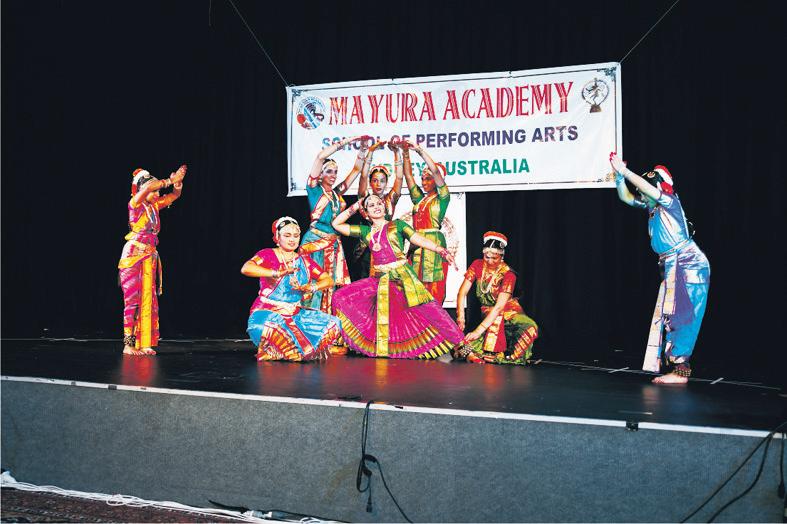
performed by students aged five years and up, and it was a feast for the eyes to watch such young children perform with grace and uniformity.
A dance sequence can never be complete without praising the god of dance, Lord Shiva. This was a performance by a motherdaughter team as Jayasree and Saakshi danced in praise of the Lord, seeking His blessings. The highlights of the performances were Tarangam and Dasavathara Sabdam Tarangam is a unique item in the Kuchipudi repertoire taken from Sri Krishna Leela tarangini, written by Narayana Thirtha. Here Meghna showed her expertise by dancing on the rims of the brass plate to mridangam beats. There was complete silence in the auditorium
as everyone was mesmerised by this captivating performance.
Last but not the least was the masterpiece, Dasavatharam. The dancers provided a visual delight by expressing the ten different avatarams of Lord Vishnu. Narasimha avataram performed by Vandana and Deepthi was breathtaking.
In the traditional Pavamana all the performers gathered on the stage to perform the mangalam The students who participated in this event were Aditi, Dhatri, Lohita, Saakshi, Sriharshitha, Anannya, Divik, Maanasa, Samhita, Sriveda, Chaitanya, Gamya, Meghna, Shilpa, Sushma, Chaitra, Harshitha, Mythri, Sree Harsha, Swetha, Deepthi, Jayasree, Richa, Sree Lekha and Vandana. All participants were presented
with a certificate and a memento by guest of honour, Dhayalan Moodley. Friends of JET Australia were commended for their diligence in organising the dinner where the proceeds would be donated to a six-month-old boy undergoing treatment for eye cancer.

To quote Natya Shastra, “Na Tath Gnaanam, Na Tath Shilpam, Na Saa Vidyaa, Na Saa Kalaa, Na Sow Yogo, Na Tath Karma, Natyesmin Yannadrushyathe” (there is no wisdom or knowledge, no art, no craft, no device or action that is not found in Natya). This is what the students of Mayura Academy under the guidance of their Guru Venkata Ramana, proved with their performances.
Anitha venkataraman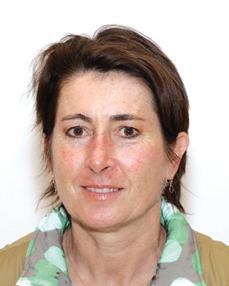
When novels or films dramatically evoke the landscape in which they are set, we can be inspired to go there. To retrace the steps of Leonardo diCaprio in The Beach, filmed on the island of Phi Phi Leh, was what I wished to do. I could travel with hundreds of tourists who arrive by ferry, or take an eminently more pleasant scenic route, exploring the islands of southern Thailand onboard the Suwan Macha, a beautiful wooden schooner rigged with the sails of a traditional junk.
My eight fellow passengers were French from the Reunion islands. A mix of sophistication and exotic elegance, surely. Shown to my cabin, several pairs of tiny legs dangled over my window and then the faces of two inquisitive girls peered at me. Five young children, all under 10! Elliot, Basil, Louis and the two impish girls, carefree, barefoot and as agile as monkeys. What delightful company they made, so curious about all that we saw.
We departed with the course set for the spectacular karst topography of Phang Nga Bay, a bizarre landscape in which limestone is weathered and moulded into unimaginably odd shapes. Massive sheer cliffs coloured white, grey and black, rose vertically from the intense turquoise water. Warrens of caves and patches of jungle clung suspended in crevices on the sides of cliffs. On a long-tail boat we explored coves with stalactite formations and passed cliffs where men climb twined bamboo poles hundreds of metres high to collect the nests of swiftlets prized by the local Chinese, a culinary delicacy for bird’s nest soup. As the sun set bringing the oranges and pinks of a tropical night and gentle waves slapped rhythmically against the boat, all worrisome thoughts were pushed far away.
Next morning we visited a sea gypsy village, passing women selling trinkets and children at play. At James Bond Island, depicted in the movie The Man with the Golden Gun, we were outnumbered by boatloads of Chinese tourists. We left for a small deserted island

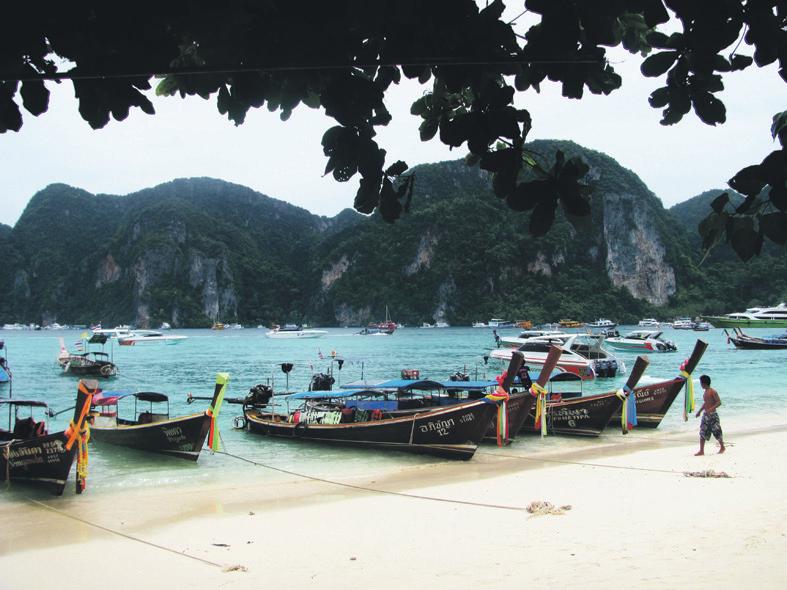
bordered by white sand beaches and went snorkelling in clear water, the coral sadly showing signs of stress.
As we approached the mainland near Krabi, the darkness of nightfall was punctuated by bright lights pointing down into the water belonging to the local fishing fleet making its way out into the night. The trip had taken several hours with the skipper appearing to hit the engine throttle hard. We had encountered large waves, it was the great wide open water and the children squealed with joy.
We put the anchor down near a small island for shelter and after a windy night, headed for Phi Phi Don, the larger of the two Phi Phi islands with cross currents causing the boat to rock from side to side, up and down. Relieved, we arrived at a beautiful white sandy bay with Chinese tourists splashing about in the shallow water. Long-tail boats passed by conveying tourists, narrow wooden vessels with an eggbeater propeller welded onto a long swinging shaft. I walked over the hill to reach Long beach, a beautiful deserted stretch of beach with several resort hotels tucked in amongst groves of palms and pandanas. Further along at Ton Sai Bay, the narrow maze of alleyways I struggled to cope. With bars displaying fairy lights suggestive of noisy evenings, restaurants, t-shirt and sarong vendors, hair braiders and tattoo artists all squeezed in with crowds of skimpily clothed backpackers, all conspired to turn me back to the relative solitude of the boat.
One of our crew was missing, but found soon afterwards with a swollen foot, a casualty of having trodden on a sea urchin. We set off for Phi Phi Leh, a small uninhabited island of white sandy beaches that juts out from the horizon, its craggy peaks and black cliffs rising dramatically. But choosing to travel during monsoon season has its risks. Raindrops as big as hens’ eggs began to fall, drenching us all.
“Isn’t that Phi Phi Leh that we’re passing, the reason why we’ve come here?” I asked. “Come on now all together, let’s wish we can go there!” But before the skipper could answer, a loud putt, putt,

fizz noise from the engine was a sign of foreboding. As the waves grew in size, crashing and lapping at the base of the cliffs, the sky turned black and the skipper sped off to get a mechanic.
The engine still would not start. The skipper announced that we would go in the rubber dinghy to Phi Phi Leh. And so it was that we landed rather excitedly on the very same beach made famous by the movie The Beach. Led to a thatched hut, we were given rice and curry by the resident ranger and his family, though as I was so seasick, I lay on the sand without moving. The storm intensified, we ran for shelter, ending up at the ranger’s hut. Exhausted, we fell
GETTING T h E r E
Jetstar (direct), Thai Airways International, Singapore Airlines, Malaysia Airlines and Air Asia fly to Phuket. GETTING A r OUND
It’s a drive across the island to the marina and a ferry boat ride. Given the ferry takes 2 hours, it is too gruelling to attempt in one day. To explore the islands of Phi Phi, an overnight stay or more is required.


As the sun set bringing the oranges and pinks of a tropical night and gentle waves slapped rhythmically against the boat, all worrisome thoughts were pushed far away
Clockwise: James Bond Island

Phi Phi Don Cruising near Krabi



The start of the rescue

The rescue is over View from Cabin Deserted island near Krabi Suwan Macha
asleep. Next morning the skipper returned, and by rubber dinghy we were taken to a diving boat and back to Phi Phi Don for our ferry ride back to Phuket.
After the ferry departed, I turned to take one last look at Phi Phi Leh. The rain had cleared and a spectacular rainbow appeared above it. The islands of Thailand are the stuff of castaway fantasies. Wishes do come true, after all!
One of the benefits of cruising onboard the Suwan Macha is that transfers from your Phuket hotel are included as well as all meals, kayaks, snorkelling gear and excursions. The boat visits islands seen by few tourists. Guest cabins for single and double occupancy are compact with shared bathroom facilities. An adventure rather than luxury experience. E: info@asian-oasis.com W: www.asian-oasis.com
wh E r E TO s TAy
For exploring the islands including Phi Phi, you’ll need pre and post accommodation stays on Phuket. I stayed at the newly opened Pullman Phuket Arcadia, overlooking the Andaman Sea and convenient to the airport.
E: H7488-RE@Accor.com W: www.pullmanphuketarcadia.com
The Beach Resort on Long beach at Phi Phi Don has helpful staff and nice rooms.
E: resvn@phiphithebeach.com W: www.phiphithebeach.com
I N s IDE r’s TIP
Contact the Tourism Authority of Thailand at Level 20, 56 Pitt Street, Sydney T: (02) 9247-7549 for brochures and maps. I’d recommend avoiding the monsoon season, November – April is high season, but the best months to go.
I walked over the hill to reach Long beach, a beautiful deserted stretch of beach with several resort hotels tucked in amongst groves of palms and pandanas
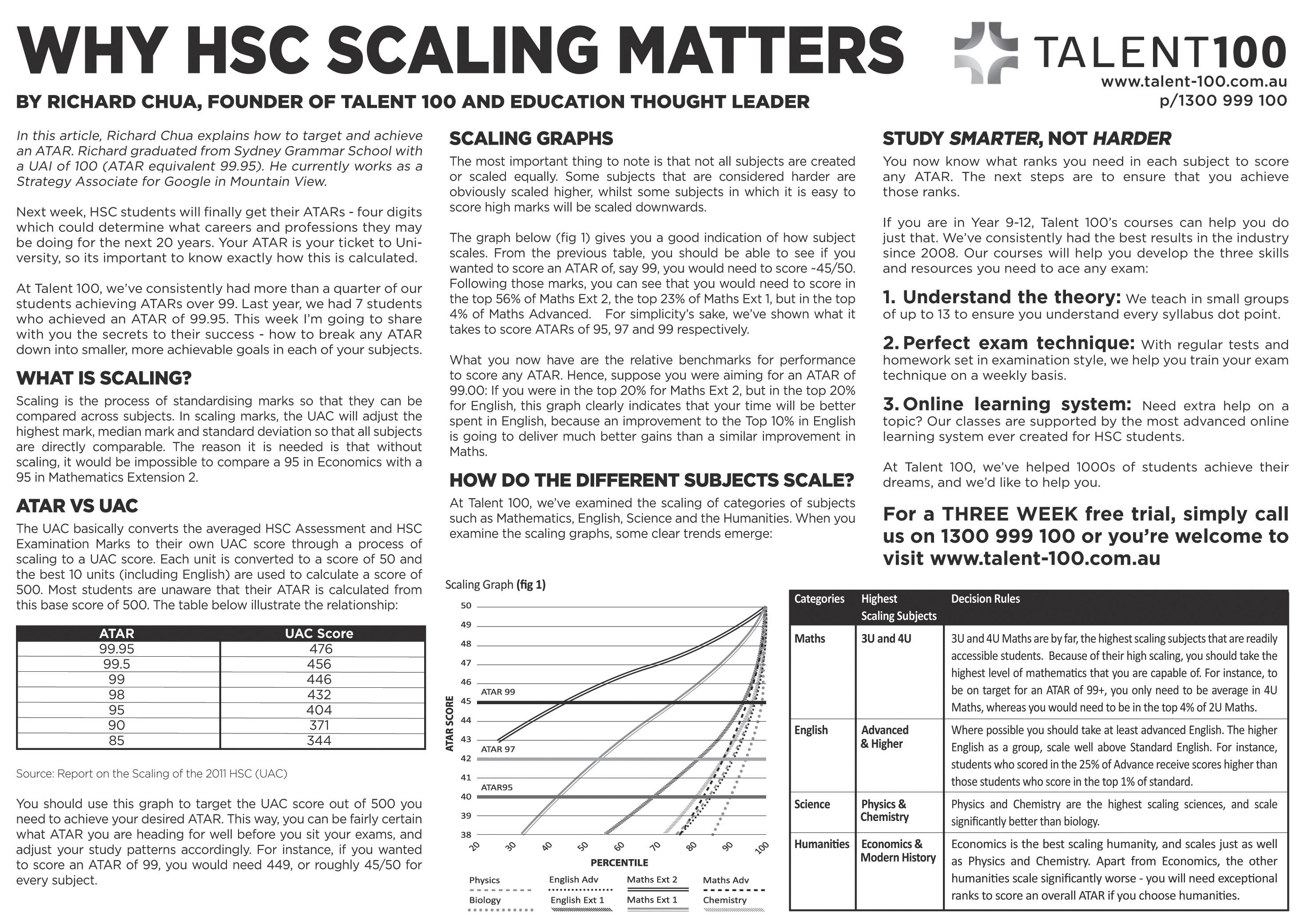

Afond Diwali memory from my childhood is cooking gujiyas with my mum. She would cook the mouth-watering coconut and sugar mixture, and I would help stuff them in the pastry and wrap them into semi circles. We would then fry them together gently, as she would recount tales of how she cooked with her own mother and her sisters.
We re-enacted this private mumand-daughter ritual when my mum visited me here in Australia one Diwali. My own daughter had just been born, and as I stood frying the gujiyas, I knew there would be many Diwali rituals I would be creating with her over the years.
Here are some of my mum’s recipes still in their original format. I’ve helped her cook from these on many an occasion, and still hope to cook them on my own (or with my daughter!) some day. The honest truth is, though, that I’m more likely to wimp out and try Indian Link’s microwave mithais
But here’s to my mum, who I am missing so much as I prepare for this year’s Diwali.

Gujiya
1 cup plain flour
3 tbsp ghee
Pinch salt
1 cup fresh grated coconut
3 1/4 cups sugar
1 1/2 cups milk
8 numbers almonds, coarsely chopped
1 tbsp raisins
1/2 tsp cardamom powder
1 tbsp poppy seeds (optional)
Oil for deep frying
Combine the salt, flour and ghee in a large mixing bowl. Rub the ghee in well. Gradually add water and knead to form a pliable dough. Cover with wet cloth and set aside.
In a heavy-bottomed pan, put in the coconut, sugar, milk, chopped almonds and raisins, cardamom powder and poppy seeds (if using), and cook on medium heat. When the milk evaporates and the mixture comes together in one mass, turn off the heat. Set aside to cool.
Take small portions of dough and roll out into little pancakes. Place a spoon of stuffing at one end and roll the side over. Gently press down the outer edge with your fingers to seal (make a pattern if you want), using some milk for moisture.
Deep fry gujiyas in hot oil till golden brown.
Meethe Chawal
1 cup rice
½ cup sugar
1/4 tsp saffron (kesar)
50 gms raisins
50 gms cashew nuts
1/2 cup ghee
5 cardamom pods
Wash and cook rice in four cups water. When done, add ghee and sugar and continue cooking on low flame. Stir continuously. Powder the cardamom and add to the rice. Keep cooking till the rice mixture leaves the sides of the vessel. Before finishing off, add saffron dissolve in a tbsp of hot milk. Decorate with raisins and chopped cashew nuts.
Burfi

400 gm tin condensed milk
300 gms grated paneer
1/2 tsp cardamom powder
2 tbsp chopped almonds and pistachios,
2 sheets silver varak (optional)
Mix condensed milk and paneer in a heavy-bottomed pan and cook on medium heat, stirring constantly. When the mixture starts thickening, reduce heat. When it leaves the sides of the pan and comes together as one mass, remove from the heat and spread on a greased tray. Sprinkle the cardamom powder and nuts on the mixture. Decorate with varak if using and cut into desired shapes.

Coconut Laddus
3 cups fresh grated coconut

2 cups sugar
1 cup milk
Heat the milk in a heavy-bottomed pan. When it comes to a boil,
add two cups of coconut. Mix well. Continue to cook on low heat until the milk is nearly absorbed by the coconut. Slowly add the sugar.
Keep stirring the mixture continuously. Increase the heat to medium and continue to cook until the mixture leaves the sides of the pan.
Empty the mixture onto a plate. When it is cool enough to handle, roll small portions of it between your palms to make the laddus Scatter the remaining coconut on another dish and roll the laddus in it.
Rawa Laddus
2 cups semolina (rawa)
1/2 cup powdered sugar
1 cup ghee
1 tbsp cashew nuts, coarsely chopped
1 tbsp raisins, gently fried 1 tsp cardamom powder.
Heat 1 tsp. ghee in a pan and dry roast the rawa till pink. Grind the fried rawa and powdered sugar in a mixer to a fine powder. Heat the remaining ghee and add the powdered rawa, cashew nuts, raisins and cardamom powder. Mix thoroughly. While still warm, mould into small with your palms. Cool and store in an airtight container.
The old recipe file is rummaged through as Diwali, the Festival of ‘Eats’, approaches

6. Printed tights: Prints can be tricky or downright winners. Pick a print that will work with your bright tee.
Whether you are a smart, thrifty shopper, a shopaholic deal hunter (like me), or a hoarder, the idea of a capsule wardrobe is sure to leave you impressed! If you are wondering what in the world is a ‘capsule’ wardrobe, let me explain briefly. It is a set of clothing, or rather essentials, that can be mixed and matched to create a wide range of outfits. The number of items in a set need not necessarily be an accurate number, however most of my research reveals a number under 30! So why a ‘capsule’ wardrobe?
I’ve been drawn to the ‘less is more’ philosophy lately. Especially after spring cleaning not just my home but also my wardrobe, I discovered that I had way too many clothes (and shoes, bags and accessories). There would be quite a few of you totally identifying with this. So let me guess, most of the purchases were made because they were on sale and simply too good to be missed at the time!
You may not like this, but my analysis is that this is not a smart shopping approach. Because if we add up the cost of all of these impulse shopping goodies, we could’ve instead bought one versatile quality item that not only lasts and looks terrific, but also works well with a number of looks. Get the picture?
This is exactly the theory behind a capsule wardrobe, to collect quality essentials gradually over time, and mix ‘n’ match in the best possible creative way to give an illusion of a varied, beautiful and luxe wardrobe.
So how could you possibly have the same wardrobe for different seasons and where do you get started? To begin with, you don’t have to have the same capsule wardrobe throughout the year. Most experts suggest actively utilising your 20 or 30 piece set for a period of three months.
Now what are the ideal items for this summer? I have put together a list of 22 items mainly based on versatility and wearability. Just add an accessory or two to be on trend, if you like.
1. Striped tee: A timeless classic, pick a style that flatters you
2. Black tank top: Versatile and chic, pick one in short sleeves if sleeveless isn’t your thing.
3. Bright coloured tee in short or three-fourth sleeve length: Aha, now this one’s interesting because you can actually pick a summery bright colour of your choice, but some of the accessories in the capsule must have accents of this colour to work in the best possible way!

4. Neutral linen shirt: Think beige or light grey here.
5. Coloured jeans: I’d suggest cream or a lighter summer colour like mint or pink.
7. Neutral cotton shorts or Capri pants: Choose whatever is in your comfort zone.
8. Shirt dress: Light denim or a pastel shade will be great.
9. Printed summer dress: I’d suggest polka dots or a light floral print.
10. Floral scarf.

11. Light knit cardigan in a
19. Neutral wedge heel sandals: Tan, off-white or sandy brown are good choices.
20. Black flat sandals: Pick a minimalist design that looks good with pretty pedicured toes.
21. Sunglasses: Aviators, Wayfarers or anything you love.

22. Floppy hat: A summer staple. The fun part is how to pair these up.

Here are a few interesting suggestions:
1 + 5 +17 + 20 +21 = Striped tee + coloured jeans + white bracelet + black flat sandals + sunglasses.
9 + 11 + 12 + 13 + 19 = Printed dress + light cardigan + neon belt + neutral tote + neutral wedge heel sandals.
8 + 10 + 16 + 18 = Shirt dress + floral scarf + pearl earrings + beige ballet flats.
4 + 6 + 20 + 21 = Neutral linen shirt + printed tights + black flat sandals + sunglasses.
2 + 7 + 22 = Black tank top + cotton shorts + floppy hat.
1 + 7 + 13 + 20 = Striped tee + neutral shorts + neutral tote + black flat sandals.
And this is just the beginning, as the list just goes on and on. Use your imagination and create a series of styles that suit your look and mood. Go on, have fun with your very own capsule wardrobe!
The number of items in a set need not necessarily be an accurate number, however most of my research reveals a number under 30!

This is exactly the theory behind a capsule wardrobe: to collect quality essentials gradually over time, and mix ‘n’ match in the best possible creative way to give an illusion of a varied, beautiful and luxe wardrobe




To help customers celebrate Diwali with their loved ones overseas, Westpac is providing customers a special Indian Rupee FX rate at participating branches along with a special fixed Telegraphic Transfer (TT) rate of only $5 for new and existing customers until November 8. As part of Westpac’s value offering for its customers, Westpac also offers bonus interest on its eSaver online savings account and a discounted home loan offer which they hope will brighten customers’ celebrations this year. Customers wanting to save will receive bonus interest for the first three months when opening a new Westpac eSaver account. Customers can enjoy ongoing access to their money via their linked account and earn up to 4.11% p.a. variable rate on their new account for three months (includes 1.61% p.a. introductory fixed bonus rate for three months plus 2.50% p.a. standard variable rate).
To help those buying property save more now and in the long term, Westpac is offering a discount of 0.90% off our standard variable rate until 29 November 2013 for new home loans of $250,000 or more under Westpac’s Premier Advantage Package. In addition, customers can also receive savings from a range of Westpac and BT Financial products and services covered under this package.
Damien MacRae, General Manager of Westpac Premium said, “Westpac has always had strong ties with the Indian community; we have a diverse workforce who actively work to serve and provide our customers with a great experience when they deal with Westpac”. “I’m delighted that we are able to continue to support the Indian community giving our customers the opportunity to save more or use the money to celebrate their new home with family and friends,” he said.

Saving on the variable rate is only one way that Westpac helps customers own their own home sooner. Mr MacRae points out a number of ways new and existing property owners could look at to pay off their home loan earlier as highlighted by the findings from the recent Westpac Home Ownership Report.
1. Use an offset account: Have your salary paid directly into your offset account so that it starts offsetting against the balance of the mortgage straight away.
2. Plan ahead: Use an offset calculator to visualise how you can save money and reduce the life of your loan. You can access this calculator at westpac.com.au/ homeowns.
3. Increase frequency of repayments: While simple this is a great way to make savings on your home loan. For example, paying half your monthly repayment every fortnight means you would make the equivalent of an extra month’s repayment every year.
4. Spend money to save money: If you can afford to increase your repayments, this can mean significant savings over the life of a loan.
5. Make lump sum payments: Consider putting any lump sums of money you receive into your offset, such as a tax refund or any bonus.
6. Take advantage of rate cuts by keeping your repayments the same. You would be surprised at how much of a difference making even small decreases will make over time.
Offshore, Westpac is building its capability in the Mumbai branch which it opened 12 months ago. The Mumbai branch is equipped to offer retail banking products and services to Westpac customers, providing a convenient and safe banking experience to the Indian community.
To find out more about Westpac’s product offerings and to find participating branches visit www.westpac.com.au today.

Seeking suitable match for fair and young looking Hindu lady, 5’ 2”, 55, divorced, vegetarian, Australian citizen. He must be a non-smoker, ideally aged between 50 and 60. Please contact: 0449 623 316 or email: alpine_rhapsody@hotmail.com
Seeking alliance for a smart, familyoriented and well-educated Ramgariah girl. She is 27 years old, 5’3” software engineer residing and working in India, but willing to move in Australia. Sister is married and settled in Sydney.
Please contact: div111982@gmail.com
Seeking match for Hindu divorcee, settled professional woman (48), living in Dandenong, Melbourne. Has no children. Please contact: vi_saw@yahoo.com or 0421 090 069.
Seeking suitable match for 36 year old, who works for a multinational company in a senior position (chartered accountant) and values both Indian and western culture. Seeking Hindu professional man, preferably from a well settled family background. Please contact: ganesh2011v@gmail.com
Seeking bride for 37-year-old 5’ 11’’ tall Melbourne based Hindu Agarwal boy. Divorced (no kids). Working in IT. Caste no bar. Contact with bio data and pic: desidownunder01@gmail.com or call / text 0416 164 651.
Alliance is invited from a Hindu, well settled and well educated Indian family for an Indian unmarried doctor guy (55), ready to settle in Australia. Please contact: vi_saw@yahoo.com or 0421 090 069.

Agarwal (Goel) boy, 34 years old, 5’8”, good looking, seeking suitable bride from a Hindu educated family. General manager with Australian company based in NCR, Delhi. Boy visiting Sydney in December and open to settling here. One aunt well-settled here. Please email girl’s details and photos to: foraanand@gmail.com
Local born Melbourne based turbaned Sikh boy with trimmed beard, 33 years old, 6 feet tall, from established family. He is a masters graduate, working as a finance manager, who is looking for a likeminded professional Sikh girl who is local born, or grew up in Australia, with a mix of western and Indian culture and values. Send interest with photos to: sikhmundah@gmail.com
Contact Details:

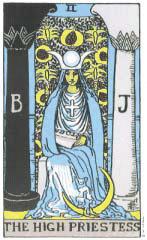
This month the card you have dominating your monthly forecast is the fool card. This shows that you are now ready for changes and need to take the challenge of bringing in all the new things that you can into your life. There are some challenges with some interference from a family member, but you have to show strength and courage. you are going to prosper if you stay calm focused and keep going. Make sure you motivate yourself.
you need to walk away from something that you have been putting off for a while. you have been very accepting of certain situations, but you now need to just let it go. The card dominating your reading is the hanged Man. you have put yourself in a state of limbo, and being this way means you do not need to make a decision. Be brave, put your best foot forward and see how great you will feel.




you are in a mood to really focus on your finances and make a habit of saving. you have been overspending lately and now is the time to take it easy with the spending. you need to be careful when speaking to colleagues or staff, as there will be hot words exchanged if you are not careful. The card dominating your reading is The Two of swords. Be aware that you are on the verge of a major decision.





This month you seem to be trying to fix problems at work or in business. you need to change the way you are working to see better results in the future. you have become very complacent lately. There is a celebration around you. you seem to be feeling a little low with regard to your love life, and the card dominating your reading is the Four of Cups. This indicates that you feel you have let someone down.



you seem to be feeling the pressure from older members in your family, and there may be some difficult situations to deal with this month. Emotions will be running high. There will be some major changes happening around you in the first half of the month. The cards indicate a sum of money coming your way, and this could be what you have been waiting for. The card dominating your reading is the high Priestess.
The cards indicate a time of stress around you this month. you may be having some problems with lovers or partners. Communication needs to be better between both of you. There is an indication of an attraction towards someone outside the relationship. There will be great news to do with overseas. Projects or plans may be coming into fruition indicated by the world card here.
The cards indicate a time of looking for property or refurbishing your existing one. There is a lot of energy around changes around the home. you are looking at increasing your assets too, so you may look at what is on the market or indeed. have a deep tissue massage. The card dominating your reading is the Two of Cups, indicating a time to be more romantic and loving.
cApRIcORN dec 22 - Jan 19
The cards indicate a time to find yourself and spend time meditating. This month will be very busy for you with work and new projects coming your way. There will be some frustration with a friend or colleague who will be pestering you for your advice. your finances will improve over the next few weeks. saving is your priority. The card dominating your reading is the Eight of Pentacles, so keep up the hard work.
you are feeling withdrawn and confused. The cards indicate that this is a time when you are trying to re-assess your life and work. you are also feeling like moving away and living on your own. This is not possible if you are married. space is what you need right now. The card dominating your reading is the Moon card which confirms the uncertainty around you. you may also be feeling more inclined towards spirituality, which is a positive sign.

This month, you will not be feeling great as things are not turning out the way you expected. someone may have recently become ill or is going through some stress which is upsetting you. you are very keen to make sure your family are all happy and at peace. There seems to be something bothering one of your children, who seems to be having bad dreams. The card dominating your reading is the Judgment Card, so get up and act.
There is a lot of focus on travel and relocation. your cards indicate that you are looking at changing your city or country. There is a lot of advice being offered to you, it would be best to follow your heart. Be careful of losing your temper as you have been under immense pressure with work or exams. The card dominating your reading is the Two of wands, looking to the future.
This month you will be in a very romantic mood. There could even be a commitment made in a relationship. Unfortunately, there may be some objection from an older woman in the family. you will feel very confused. The sun card is dominating your reading which shows that you will win with careful speech and kind actions, so keep this in mind. you need to look after your legs.

HHHHH
The second-half of this breakneckspeed, blues-chaser of a movie opens with a long chase sequence through the narrow gallis of a dusty small-town in North India where we last saw Akshay Kumar having a ball in Rowdy Rathod and Khiladi 786

somehow in those films, Akshay ended up having more fun that we did. This time, our enjoyment-quotient matches
Akshay’s step-by-step, scene-by-scene, frame-by-frame chuckle for chuckle.
Boss is as much fun to watch as it must have been to shoot. Almost every sequence is an ‘item’. And for once the word ‘item’ is not a gaali.
Director Anthony D’souza who failed so miserably in shooting an undersea adventure thriller in Blue, here rises out of the deep to deliver a full-blast rabblerouser that verifies what Vidya Balan recently said about the movies: “They are all about three things… entertainment, entertainment, entertainment”.
To that we can add another golden rule of honest mainstream filmmaking: kinetic energy. Every moment in Boss is a celebration of cinematic conventions derived from decades of Bollywood entertainment.
Family-ties torn asunder by villainous machinations, brothers growing up with different values, and a parent who
frowns at the outlawed son’s ill-gotten wealth power.
Damn, Mithun Chakraborty as Akshay’s disapproving father could be Nirupa roy in Deewaar. But I doubt Amitabh Bachchan’s character would see the humour in the violence the way Akshay does. he stops a bone-breaking binge for a titter and then goes right back to thrashing his enemies.
Then there is the deliciously subverted morality of la-la-land. A law-maker who breaks every law of the land, and an anti-social hero who could have ended up being boringly messianic. But just as the character seems to take itself too seriously, Akshay Kumar brings him back a thumping thud, the kind that creates a crater in the ground.
Akshay, God bless his innate sense of joie de vivre underlined by a distant demeanour of unspoken tragedy that shows up in a welter of wistfulness, imparts to the old-as-the-hills heroism, a sense of freshly-found humour.
A sense of sameness had crept into Akshay’s recent serio-comic outings. But in Boss, he bites succinctly into his juicy role, creating a kind of precarious balance into a part that blessedly careens more towards self-parody than self-glorification.
And thank God for a formidable adversary! That brilliant actor ronit roy as Akshay’s main opponent - a khaki-clad brute named Ayushman Thakur, brings to his role a chilling propensity to turn the colour khaki into a black display of uniformed anarchy.
ronit’s introductory sequence where he ritualistically murders a cluster of
writer sajid-Farhad have completely reconstructed the material bringing a sense of surging excitement and great fun to the proceedings. The dialogues are bombastic but not repeatedly so.
The elaborate action sequences devised and executed by Anal Arasu are the backbone of the robust narration. Every action sequence is done with virile innovative enthusiasm, thrilling and rugged but never oblivious to the need to lend laughter to the bloodshed. hence when Akshay fights a bunch of boorish goons in the first of the many cleverly-executed stunt sequences, out come huge music speakers and three chorus dancers to lend his fisticuffs a rhythmic
designed scenes (one sequence has the formidable Danny Denzongpa standing around doing nothing, something that this actor is not comfortable doing) and some sidekick characters who are annoyingly intrusive, I found myself completely entertained by the film’s light-weight tone.
This is a fast-paced, zany, full-on masala fare. There is a tempting swagger to Akshay’s performance matched by the narration’s tidal tempo. Irresistible energy and endearing gusto underline the show’s voracious appetite for a comic kill.
Ekdum fit hai, Boss!
S UBHASH K J HA

STARRInG: Manish Paul, Eli Avram, Varun Badola, Manish Choudhary
DIReCToR: saurabh Varma
HHHH
Mickey Virus is Bollywood’s first full-fledged film on the virtual world. The hero -if we may call Manish Paul’s languid lazy vagabondish character that - is a computer hacker, and one who likes to take his time over every punch of the keyboard.

Mercifully, debutant director saurabh Varma’s film moves in a mood defiantly opposite to the hero’s indolent indiscretions. Tightly-scripted, cleverlyworded and arrestingly encrypted, Mickey Virus drags the hackers’ hemisphere into hectic mode.
In this slickly-executed cyber-drama, our debutant hero and his comp-friendly pals (with names like ‘Floppy’ and ‘Chutney’) make for enjoyable viewing. The film is voguish, vibrant, vital and viral, and yet extremely fastidious about keeping the plot above the temptation of throwing virtual weight around.
This is a well-woven thriller about an average 20-something Delhi dude who falls in love and into a cyber-trap, hitting his head into a scam that could destroy his life.
To reveal any more of the plot would
be akin to giving away the film’s UsPs. suffice to say that Varma knows his cinema as closely as he knows his computer. he weaves cinematic elements into a kind of one-night-inthe-life-of... tale that spins in dizzying motions.
Delhi is again caught in sinister provocative postures, and every outdoor location has a story to tell. strange, how Manish, switching effortlessly from his cocky on-stage antics on reality shows to a kind of languorous screen appearance, pulls out all stops to make Mickey look real to the point of being your next door neighbour’s son.
Manish is goofier, more adventurous in his exploration of adrift urbanite. he is an interesting actor with an unpremeditated screen presence.
Mickey Virus gives the debutant a chance to romance the dark side of youngistan with unselfconscious fluidity. There is also a cutely written romance woven into the hacker’s tale. Eli Avram shows up as a manifestation of Manish’s virtual fantasy, named ‘Kungfu Chameli’. There is an endearing courtship, blessedly not over-punctuated by songs. Manish’s Mickey probably doesn’t even watch Bollywood films!
The debutant has accomplished actors around him for support. Manish’s namesake Manish Choudhary is a stern placid police officer who needs Mickey’s
hacking skills to track an international gang.
Choudhary is in fine (uni)form. But the very talented Varun Badola as Choudhary’s assistant is a scene stealer. Mouthing the film’s catchiest lines casually, Varun brings more to his role than what’s written for the character. The rest of the supporting cast too gets into the mood of the plot.
Undoubtedly, Mickey Virus is Manish’s made-to-order vehicle. he casually invites us into his suddenly-troubled world, and then persuades us to cringe at the progressive crisis built around Delhi’s cyber stratosphere. The uniqueness of the plot works effectively in covering up the loopholes and rather embarrassing coincidences that bridge various dramatic elements in the plot. It
STARRInG: rajkumar yadav and Tigmanshu Dhulia
DIReCToR: hansal Mehta
HHHHH
Stop right here. Shahid is the sort of rare, raw, unnerving journey into a socio-political reality that our cinema needs to undertake regularly, but seldom does. hansal Mehta’s film on the real-life slain lawyer shahid Azmi is a fearless work. Fearless and unfettered, Mehta wastes no time in establishing the monstrous marginalization of the Muslim community in a society where terrorism has blurred the majority community’s sense of propriety, to the extent of unmitigated bigotry. Shahid is an exposition on abject isolation. There is a harrowing sequence of police brutality in the film where the film’s Muslim lawyer-hero sits on the hard floor of a police station stark naked shivering, as the cop repeatedly accuses shahid of terror activities. The protagonist’s absolute humiliation at that point in the narration hits us where it hurts the most. Predominantly Shahid is about an
impatient society anxious to find scapegoats for growing violence around us. In a language that embraces the complexities of Islamic isolation, Mehta’s film cracks open the code of that unexplored genre of cinema known as the drama of persecution.
In Shahid, Mehta chronicles the life of lawyer shahid Azmi with deft clenched directness. The silence of the night is punctured by the shrill sound of the phone. slurred threats are hurled. Taking the abuse on his chin, the crusading lawyer, played with scintillating austerity by r ajkumar yadav, sits stoically at the centre of the debris of destruction of distrust as he undertakes a jehad to prove the innocence of the arbitrarily accused. There are some highly poignant electrifying courtroom sequences shot with the languorous devastating dinginess of courtrooms that have killed off all chances of justice for the damned. what would those wretched TADA undertrials, locked up and left to languish for life, have done without shahid Azmi to fight for their lives? The character has been portrayed by the very gifted r ajkumar yadav whose forte is underplaying, imbues shahid’s

role with the kind of tightly-reined tumult and an unspoken anguish. The performance deserves a standing ovation, primarily because it doesn’t scream for attention. In comparison, the other performances appear pale and distant, albeit authentic and thoughtful.
Tigmanshu Dhulia is notably powerful in a brief cameo as an eminent lawyer. shahid’s relationship with the divorcee mother is never satisfactorily rounded up nor assimilated into this courageous man’s fight for justice for those who are condemned not only by law, but by social stigmatization. The protagonist’s yen for justice comes across with forceful impact. he has experienced the worst humiliation and suffering in custody, but won’t allow the same shame and pain for those who are wrongfully confined. he means business, we must hear his story. Of course, he pays with his life. whether it’s romeo or shahid, all heroes must come to a suitably sticky end. That’s what you get for trying to be a hero.
Shahid is a crucial document of our troubled times. It builds an incredibly
does get far-flung. But the leaps are made without fractured bones.
Quirky, colourful, agile and hectic, Mickey Virus is a ‘virtually’ interesting way for the team to start their respective careers. This is an oddball of a movie that tries to make sense of the senseless whirligig of urban internetdriven lifestyles. what the ‘hack’! Just go out there and have fun.
S UBHASH K J HAgripping case study of persecution and vindication, with a treatment that is never ponderous or polemical. Mehta has set out to convert the slain lawyer’s valorous tale into an authentic exposition on the residue of retribution. And the result is so darned gripping. Shahid is a must-see film with an absolutely impeccable subtext, reading as an urgent warning against the politics of isolation practiced by many political parties. Be warned. you might be voting for violence.
SUBHASH K JHATalented actor Irrfan Khan never fails to surprisecertainly not when he says he will be ready to sing or play an instrument if a movie allows him to do so! The actor is an ardent music lover and says he is yearning to feature in a film which lets him explore this love of his life, and perhaps lend him a chance to learn the saxophone.
“I’m dying to do a film about music. I want to do such a film so that I can live sometime with music, through which I can explore music,” Irrfan said recently. “I’m finding an excuse to live with music for sometime now. I love music of all kinds, classical, pop, jazz... whatever. singing or playing an instrument... anything will do. I can always learn how to play an instrument. I have always desired to learn how to play the saxophone someday,” he added.
“I want to do a film for children, I want to connect to children. I want to do a great action film and yes, also romantic films... Oh God, I feel like I’ve just started acting. But that’s what it is about... I want to do wonderful films which people cherish for years to come,” he said.
It’s a different thing that he has already been delivering films like The Namesake, Maqbool, Life In A... Metro, Paan Singh Tomar and The Lunchbox Qissa is likely to add to the list. The film is a thought-provoking drama about a delusional man who faces a reality he is unable to accept, which has already got stupendous reviews from viewers at film festivals. Qissa is a result of many ‘tales’ of partition that director Anup singh has heard from his grandparents over the years. The stories stayed with him. set in post-partition era, the film focusses on the life of a sikh named Umber singh and his family. It talks of the family’s displacement from the Pakistan region to the Indian side of the border, and Umber’s obsessive desire for a male heir.
Veteran actress hema Malini, who recently performed at a special concert in Agra, has strong views on item numbers currently so popular in Indian cinema. “Nritya was my puja. To save our culture we will need to return to classical dance forms and music. Item numbers will neither save India nor our culture. In Bollywood, nobody these days asks new actors whether they know or understand the nuances of classical music,” hema stated recently. The actress has mesmerised many with her classical dance performances on stage and even in her movies throughout her varied career. Perhaps hema has a point, and Bollywood belles should start taking more of an interest in the classical side of Indian dance. But will the film-going audience appreciate ragas instead of rap and graceful movements instead of hip-thrusting gyrations? what do you think?

“Doing different things sets the equilibrium. Every time you take up something new, it relieves you and gives you freshness. In fact, if you do one kind of thing all the time, then the question of finding equilibrium arises. I have been fortunate to be able to different things,” said Irrfan, who, as a child, couldn’t even muster the courage to pronounce his name to his teacher.
“Nobody ever imagined I would become an actor. I was so shy,” he revealed, sharing his story of conquering his fears and becoming the global star that he is today. Bet the next movie Irrfan makes will be on music, it’s too good a chance for moviemakers to miss!
Priyanka powers on Actress Priyanka Chopra is on a roll with her latest Ram Leela item number titled Ram chahe leela, that crossed over one

million hits in just three days on the India iTunes charts. The actress-cum-singer is naturally overwhelmed by the response from her fans and admirers. The dance number in the sanjay Leela Bhansalidirected film is done as a mujra by the actress, but in a contemporary format, whatever that’s meant to be.
Priyanka took to Twitter to thank fans after hearing the news, tweeting: “Milestones..yesterday ‘Exotic sales’! Today Ram chahe leela (crosses) one million (hits) in just three days and Krrish 3 trailer (crosses) 17 million hits! woohoo! Thank you all so much”.
Priyanka has also recorded tracks with international singers like Pitbull and will.i.am. And she is willing to go wherever her work takes her. “Even my music wasn’t planned. I consider myself an actor, be it in hindi films, English, Punjabi, Tamil, it doesn’t matter, as long as it is a fun part. I don’t make plans, I am not saying that I am going to establish myself in hollywood,” the 31-year-old said recently.
Meanwhile, Priyanka confesses that she would love to sing for a contemporary actress as long as the song is good. “I think it will be very cool if I can sing for another actress because now I am a professional singer. But my voice is distinct so, I think it will be too much of a disparity,” Priyanka said.

“But it doesn’t depend on actors, it depends on the song. I like singing, so the song should be good. (I would like to sing for) any of my contemporary actresses, they all are so great,” she added.
And now the actress has revealed that her third single is expected to release in December. “ we are working on my third single right now and that should come out by December. The vocals are done, we are just doing production. right now, it’s just me, it’s a solo single,” she
stated. “If this song sounds like it needs someone else then may be there will be a collaboration, but I can’t say anything right now,” she added. Looks like we’ll be seeing a lot of Priyanka on the music and movie scene!
Like all good parents, actor Abhishek Bachchan has positive aspirations for his almost two-year-old daughter Aaradhya, and one of these is the hope that she continues to appreciate her parents the way he still respects his. “I just hope that when my daughter turns a teenager, she continues to appreciate her mother and father the way I still respect, acknowledge and love my parents for all that they have been doing for me,” said Abhishek recently, at a book launch in
Mumbai. His parents Jaya and Amitabh Bachchan certainly seem to have done a great job in bringing him up. And I’m sure wife Aishwarya agrees to his tip on positive parenting. The 37-year-old will next be seen in Dhoom 3 and is currently shooting for Farah Khan’s Happy New Year. Good luck with Aaradhya, Abhishek, perhaps she’ll be a teen star!


The 7th Asia Pacific Screen Awards (APSA) to be held on December 12 in Brisbane will see renowned Indian screenwriter and director Shyam Benegal leading the international jury of six highly acclaimed filmmakers, in his capacity as President. In addition to Benegal, Korean screenwriter and director Kim Tae-yong, ‘Queen of Sri Lankan Cinema’ actress Malini Fonseka, Turkish actor Tamer Levent, Swiss director Christoph Schaub and Hong Kong producer Albert Lee will comprise the
jury at the festival. The international jury is tasked with determining this year’s APSA winners from an extremely high calibre of nominees. “As India celebrates 100 years of cinema, it is fitting that the International Jury be led by a filmmaker of such gravitas as Shyam Benegal. “Brisbane’s Lord Mayor Graham Quirk is thrilled that Mr Benegal accepted our invitation, and looks forward to welcoming him and his fellow jurors to Brisbane,” he added.
The APSA are the region’s highest accolade in film, recognising and promoting cinematic excellence and cultural diversity of the world’s fastest growing film region: comprising 70 countries and areas, 4.5 billion people, and responsible for half of the world’s film output. So keep an eye out for some excellent films coming to Brisbane this summer!
Manna Dey: no more at 94

Legendary singer Manna Dey passed away on October 24 after a prolonged illness at a private hospital in Bangalore, at the age of 94.
Braving a downpour, hundreds of people, including youths, thronged the Ravindra Kalakshetra, a theatre in the city centre to pay tributes to Mannada after his frail body was brought from the hospital. Paying a tearful adieu to the singer were his family, friends and fans.
Sonam Kapoor or Kelly Brooks in Dolce and Gabbana?


Later in the day, his mortal remains were consigned to the flames by his younger son-in-law Gyanranjan Dev as per Hindu rites at a crematorium. About 500 people, including relatives, friends and fans were present at the cremation. “A few members of the Bangalore Bengali Association sang a song penned by Nobel laureate Rabindranath Tagore at the funeral,” said Dey’s friend Runa Roy. The nonagenarian multi-lingual singer is survived by two daughters, Rama and Shumita, sons in-laws and grandchildren. His wife Sulochana Kumaran had passed away in January 2012 due to cancer. In a career spanning seven decades since 1943, Mannada, whose original name was Prabodh Chandra Dey, sang over 3,500 songs. the six songs early this year. RIP, Manna Dey, Indian music has truly lost a legend!
What’s the chitchat here between Madhuri Dixit and Sridevi?

Send in your responses to win@indianlink.com.au and win a surprise prize
What’s the chitchat here between SRK and Madhuri Dixit?

Mads: Shahrukh, we’ve got to stop sight-seeing and get to Sydney Olympic Park. Our show was supposed to have started an hour ago!
SRK: Relax Madhuri. Sydney’s Indian community is so bewakoof they’ll even wait for three hours. Come, let me take you to David Jones…
Nisha wins a free ticket to the new Hindi film Satyagraha

With Diwali just around the corner, my thoughts invariably go back to my childhood and our myriad of festival celebrations back in Mumbai. Of these, a couple of episodes stand out clearly from the others, simply because they enlivened even more, what was normally an interesting festival.

My dad worked for a bank, and the week preceding Diwali was always a highly anticipated one as he would come home bearing various gift boxes from generous clients, usually containing an assortment of dried fruit and nuts, or mouth-watering mithai These boxes would be attacked by the family; we were all relatively healthy eaters, and the first to go would always be the cashew and pistachio nuts.
Soon, all that would be left behind were a few dried dates and sultanas, which no-one particularly enjoyed, not even the maids. Because our household was one that saw an influx of visitors over weekends ranging from family to hanger-ons looking for a free meal that my kind parents wouldn’t refuse, one year my dad insisted that a few of these gift boxes should be
kept aside to re-gift, as we were clearly being spoiled for choice. My older sister was the only one who vociferously objected to this generosity, perhaps because she had a penchant for nuts, being one herself. She developed a technique by which she would gently lift the cellophane paper that covered the compartments in the box, and would replace the nuts with the unpopular, leftover sultanas. She would then glue back the cellophane paper, replace the lid of the box, and to ensure that she hadn’t been detected, she would seal the box with sticky tape at each end. I wonder how many recipients of those boxes were grateful to the dubious generosity of my family.
Despite living in a predominantly Catholic area (indeed, the locality I lived in was called ‘Catholic colony’), when it came to Diwali, we put aside our Christian snobbery and rivalled the neighbouring ‘Hindu’ gangs with a collection of fireworks that was on par with theirs in cacophony and splendour.
Each Diwali my dad would religiously travel to a special fireworks shop in Muhammed Ali Road, owned for generations by a Muslim family, and would spend a good bit of his hardearned festival bonus on buying an array of rockets, sparklers, fountains, Catherine wheels and, my favourite, since I was (and am) an irredeemable funk, little black pellets called ‘snakes’ which when lit, flared up into a tube of black
carbon with an odious vapour. They were stinky, but safe.
I have always been a reluctant admirer of fireworks and as a child the nearest I could get to firecrackers was reluctantly holding a lit sparkler balanced at the end of a stick, thanks to the ingenuity of my mother, whose coaxing had also got me out of bed with pillows over my head. I loved the colours and lights that accompanied Diwali, but not the sound. And Bombay being an enthusiastic city, always began its noisy celebrations at least two weeks before the festival. Loud ‘bombs’ went off at 3am, literally shaking the neighbourhood on its foundations, and all most people did was rollover in their sleep.
One of my most memorable Diwali celebrations however, was right at home. Our ground floor flat had a balcony overlooking a garden that ran around the premises, the abode of many childhood adventures and home to a few cats. As is typical with homes in the city, we had one part cordoned off with old furniture, a bookshelf with moulding books, and various bric-a-brac that noone ever seemed to find the need to throw away.
My sister as usual, the tomboy of the family, often took her enthusiasm for life several notches higher when it came to fireworks on Diwali, and was the one to light the rockets, Catherine wheels, fountains, etc., while the rest of the family watched admiringly from a distance. Now this Diwali,

finding herself overwhelmed by the abundance of fireworks, she decided to sneak in a few early ones before we went out to add our stash to the communal street one.
The problem was that lighting any of them in the garden would alert the neighbourhood to a private party, besides scaring the cats. And so she decided to light them on the balcony. All went well as sparklers were lit and the maids joined in to watch the fountains shoot up in wonderful hues of gold, blue and orange, leaving behind only faint scorch marks on the ceiling. The fun really began when she started lighting the Catherine wheels. Now these annoying things don’t just spin in a small circle, sometimes they take on a life of their own and traipse all over the floor.
One particularly enthusiastic specimen did just this and with its dying whirl, went straight under the pile of junk at the far end of the balcony. “Don’t worry,” said my sister with admirable nonchalance, “It will go out by itself”. A few minutes later, a particularly acrid smell began to fill the balcony, and flames began emerging from the junk.
Fortunately our stalwart maids hotfooted to the bathroom and soon buckets of water were poured over the flames, while the rest of us gaped in astonishment. Luckily no one was hurt, and the subsequent stories of heroic rescue would have, in today’s day, made the media frenetic.
“Don’t worry,” said my sister with admirable nonchalance, “It will go out by itself”. A few minutes later, a particularly acrid smell began to fill the balcony, and flames began emerging from the junk
We however, had to be content with sheepishly answering curious neighbours’ questions. Long after the fire was put out, my mother still poked at the mess of ash, water and debris to convince herself that there were no stray flames that may unexpectedly come to life again. Our stash of fireworks was confiscated for a day, my sister got a mild telling off (it was, after all, Diwali), and the maids earned their Diwali baksheesh
Memories of Diwali are incomplete without episodes that contain these two essential symbols of celebration
Loud ‘bombs’ went off at 3am, literally shaking the neighbourhood on its foundations, and all most people did was rollover in their sleepSHERYL DIXIT


The Indian love affair with gold can be traced back thousands of years – from past empires to present day political figures and celebrities – they have all taken a strong interest in gold investments.
In fact, the Indian government plays a crucial role in the world gold market and the Central Bank of India has accumulated significant gold reserves with consistent buying over the last several years. While the government uses gold investments as an economic hedge, the domestic sector has also increased its gold holdings for cultural and traditional reasons – particularly for weddings and cultural festivals, as well as investing for their children and grandchildren.
Gold has been around forever, why buy it now?
With the increasing global economic distress, gold has emerged as a safe and liquid form of investment. The extreme volatility of the world markets and their bleak performance has undermined investor confidence. Further instances of currency printing will only contribute to the rising inflation rate.
For investment purposes, gold is offered in three forms: Cast Bullion, Minted Bullion and Coins.
• Cast Bullion: Pure gold poured (or “cast”) into bars of varying sizes.
• Minted Bullion: Pure gold bars that have been polished and bear the stamp of the refiner.
• Coins: More appropriate for advanced investors as the gold coin market is more complex than the bullion market. Coins have a face value and some are collectors’ items.
Before rushing over to a bullion dealer, you need to set your budget. Gold bullion is available in a range of sizes starting at 1 gram and going up to 15 KG – so there will be an option for you no matter what your budget. Generally, most people choose the standard 1 ounce, 50 gram or 100 gram bars, which are easy to store and liquidate due to their popularity.
Unlike buying a piece of gold jewellery which is often sold at a fixed retail price, the price of buying gold bullion is ever-
changing, and is calculated as the spot price plus premium. The spot price is the base price quoted on gold markets. This is the price at which huge central banks can buy their gold investments. For the rest of us, we need to pay a premium on top of this spot price to acquire our gold. The premium consists of the refiner’s cost of minting the bullion and the seller’s commission.
Depending on the volume of gold you are purchasing and your bullion dealer, there can be a significant difference in the commission costs (premium). So, it is worthwhile doing your research and shopping around. Like most products, premium is proportionately lower when you are buying a larger bullion product. It would be worthwhile to diversify your gold bullion in some smaller and more liquid bullion (e.g. the 1 ounce bar or 50 gram bar) rather than investing in one large bullion that is equal to the whole of your budget (e.g. a 1KG bar).
Step Three: Choosing a trustworthy dealer
Purity is crucial when it comes to buying gold: just as you seek the most karats in your gold jewellery, you will need to be certain about the purity of your gold bullion.
The purest gold bullion is 99.99 pure (the four nines) and investment grade bullion will always have 99.99 or 9999 stamped on the gold bar.
Looking out for the 9999 and the refiner’s stamp is important as some traders try to make their own bullion by melting gold jewellery – which leads to an impure product mixed with other metals. It is absolutely imperative that you only buy from a reputable and trusted dealer that only sells investment grade ‘four nines’ bullion such as Perth Mint, PAMP bullion or ABC Bullion.
Step Four: Storing your gold
As with your precious gold jewellery, you must secure your gold bullion in safe storage such as a personal safe or bank safe custody vault. If these options are not available to you, you will find that the most trusted bullion dealers also offer storage facilities and will even insure your investment for a small fee.
Buying gold in Australia: The quick 4 Tips
1. Choose bullion from brands
which are classified GST-exempt in Australia, such as PAMP, ABC Bullion and Perth Mint.

2. Purchase bullion from a large, trusted dealer who will guarantee to buy back your bullion when it comes time for you to sell and has a physical office/showroom presence.
3. Purchase bullion from Authorised distributors of the products they sell to ensure the products are received direct from the source.
4. Avoid derivative products such as gold ETF’s (Exchange Traded Funds); this is “paper gold” and its value does not necessarily reflect the gold price.
Ossie Ahmad is the General Manager of Bullion Money, one of Australia’s largest bullion dealers. For more information please visit www.bullionmoney.com. au or come and see us at our office – Level 1, 9 Phillip Street, Parramatta. NSW 2150




